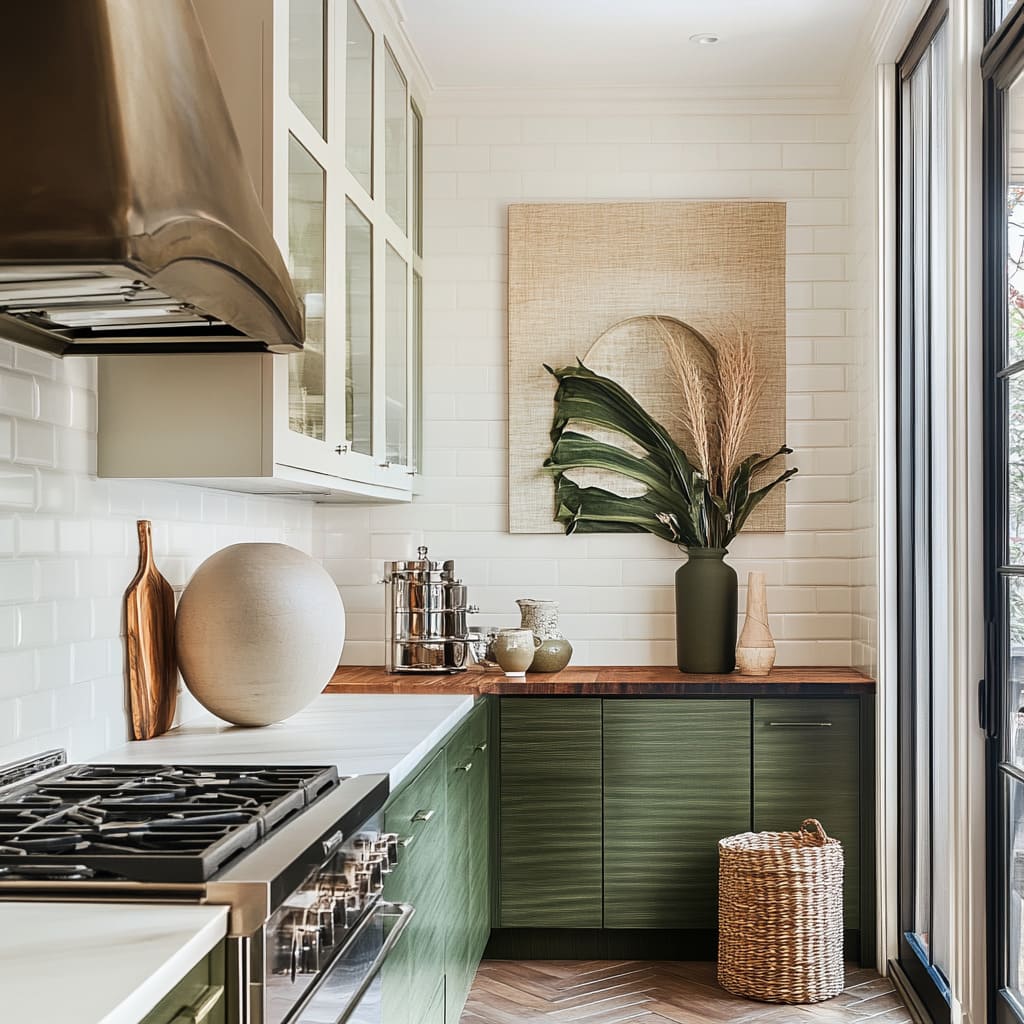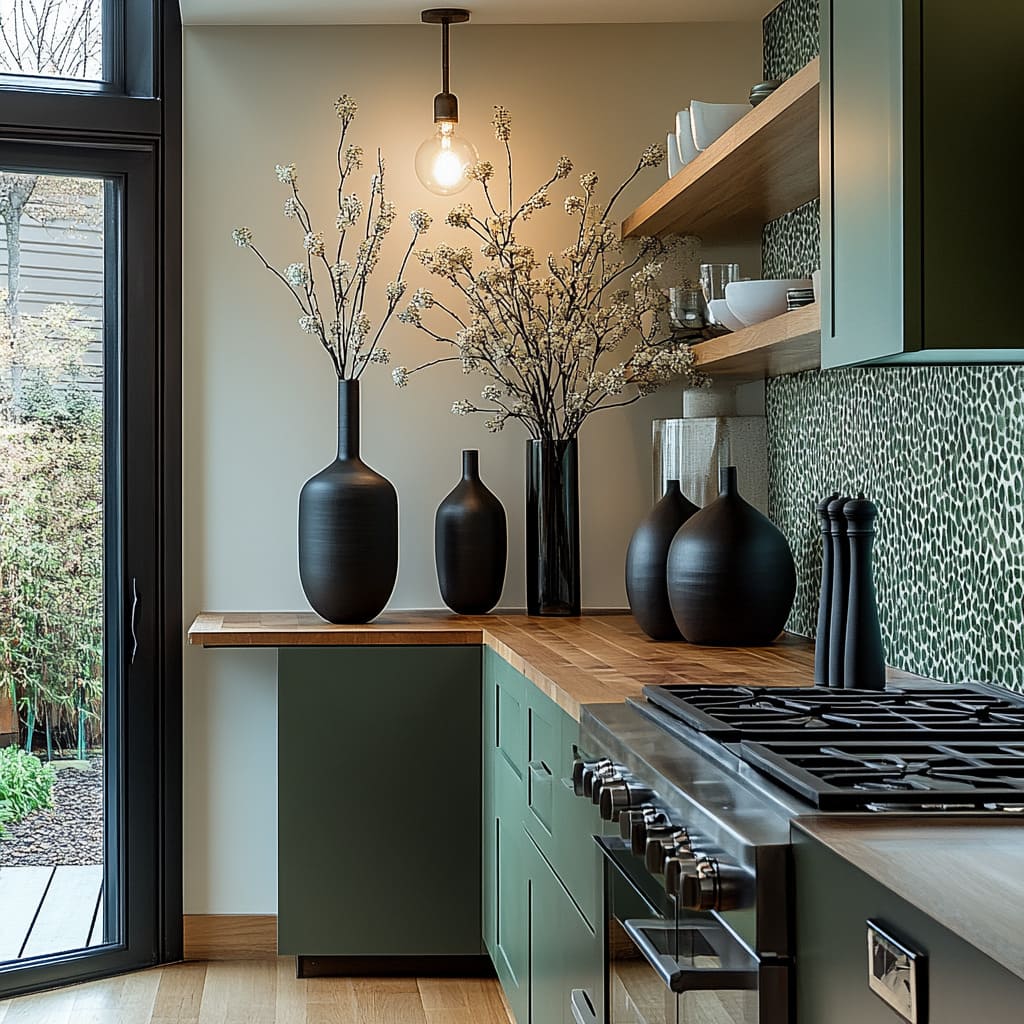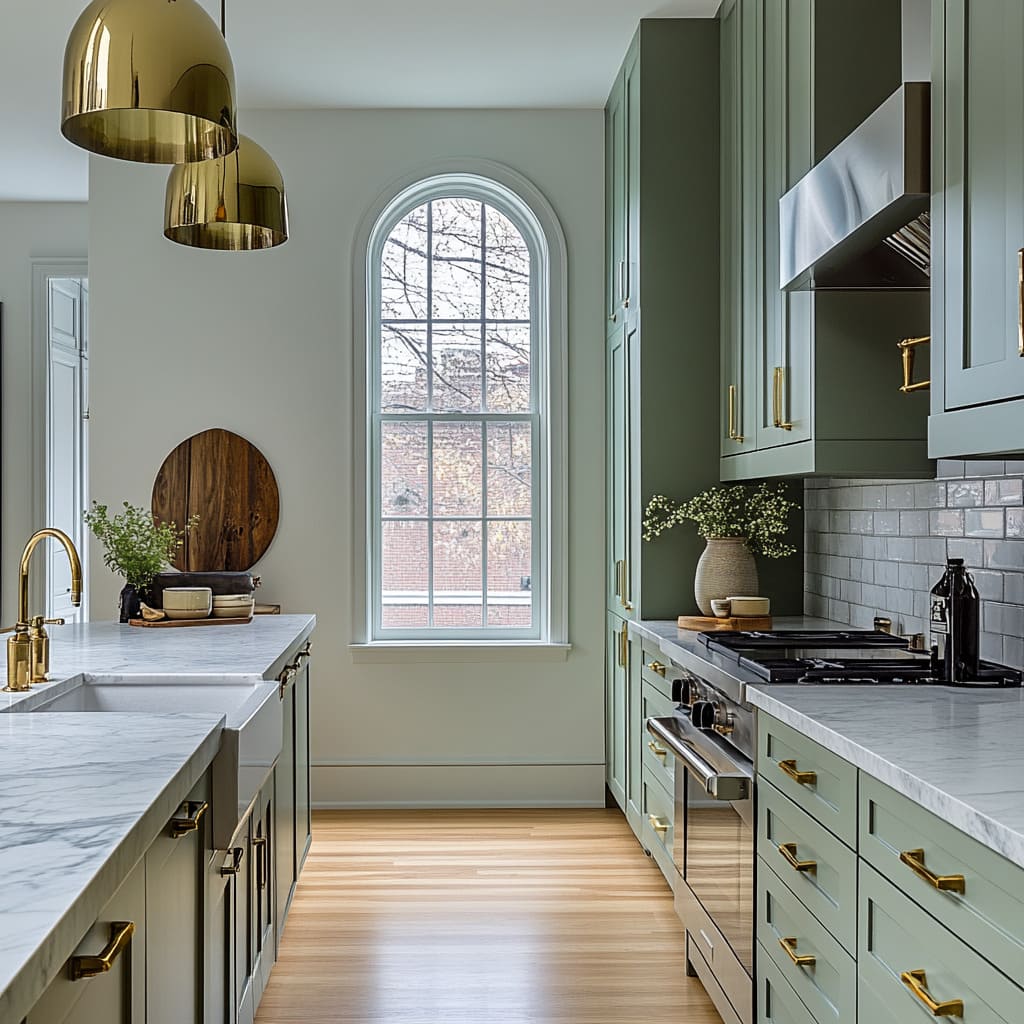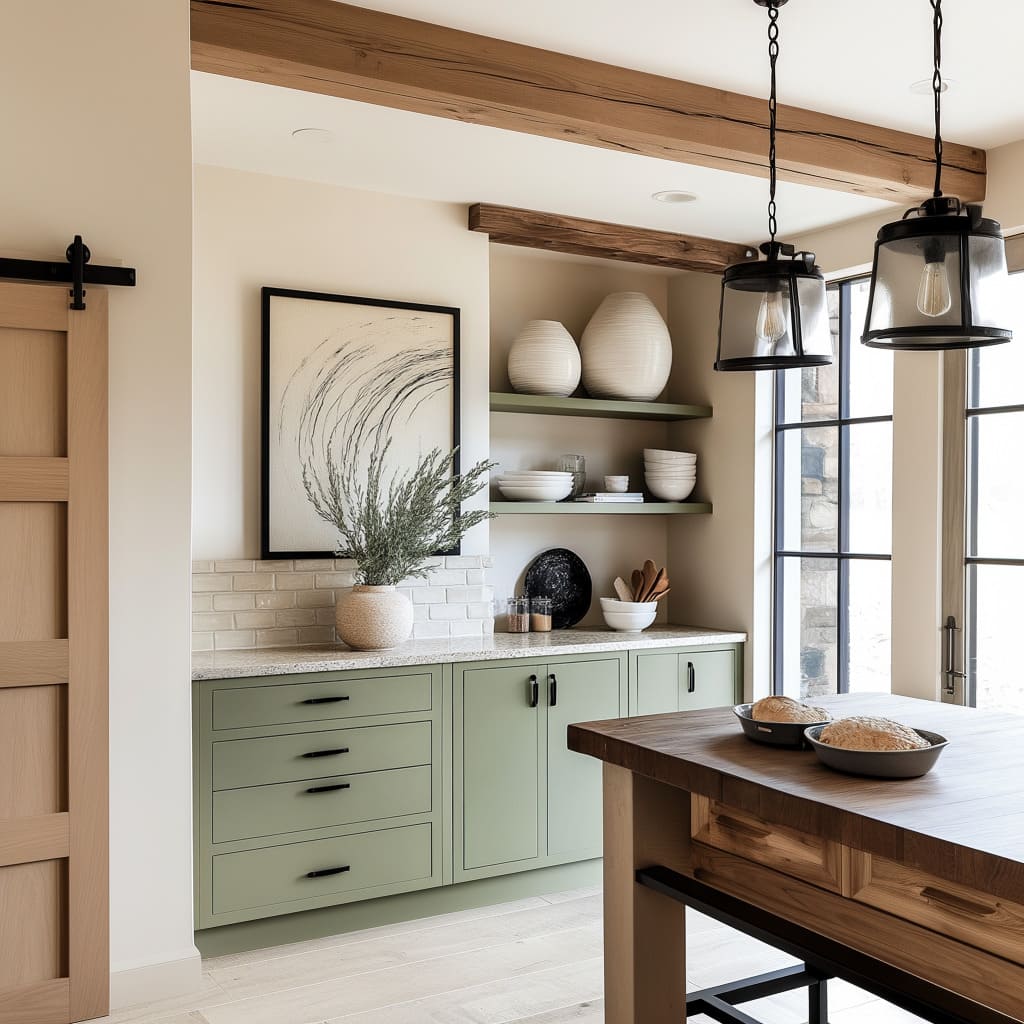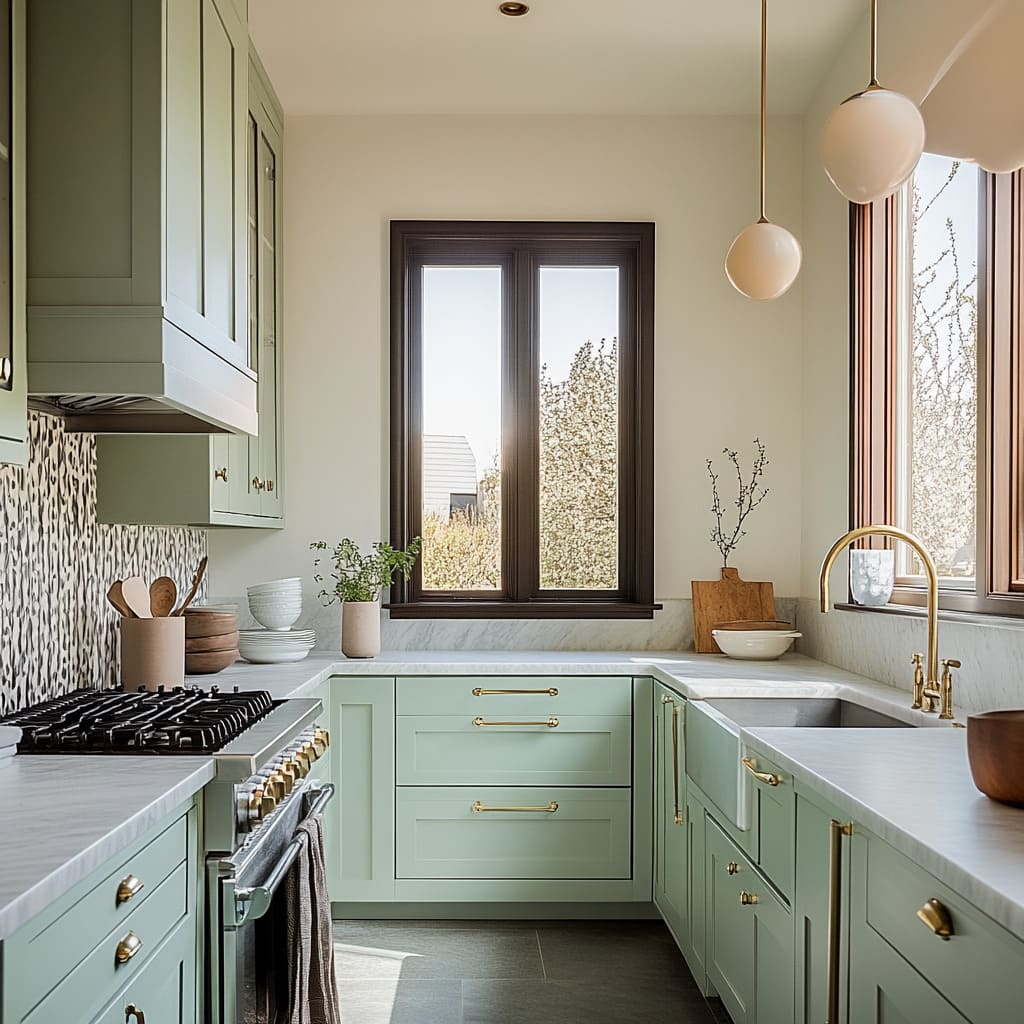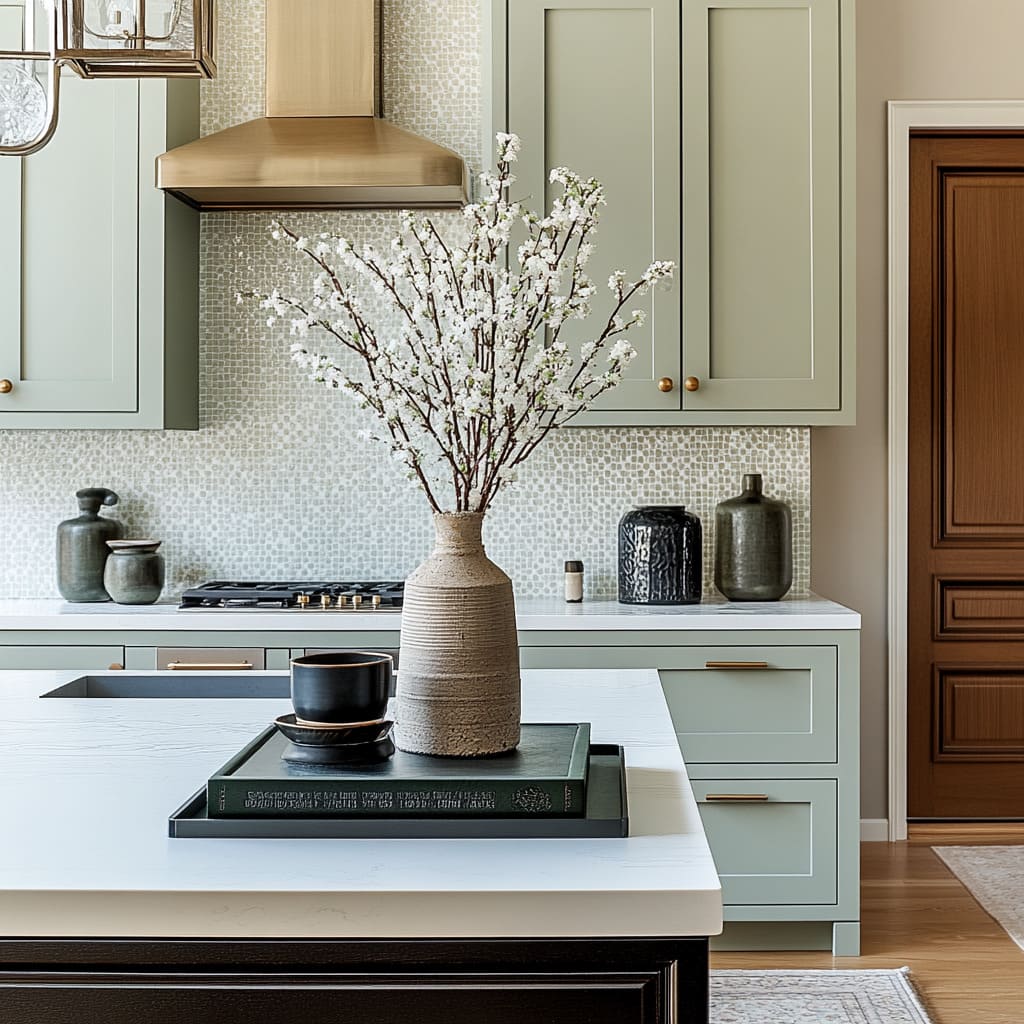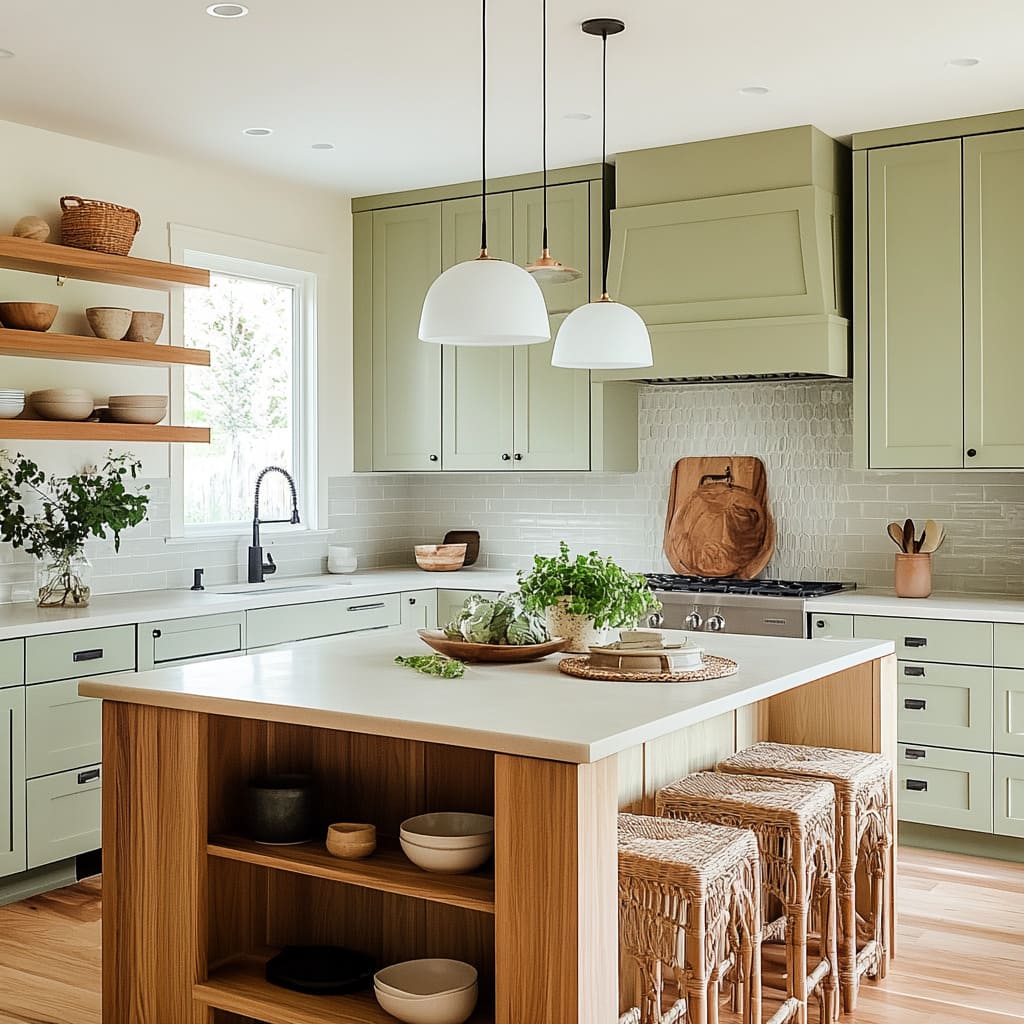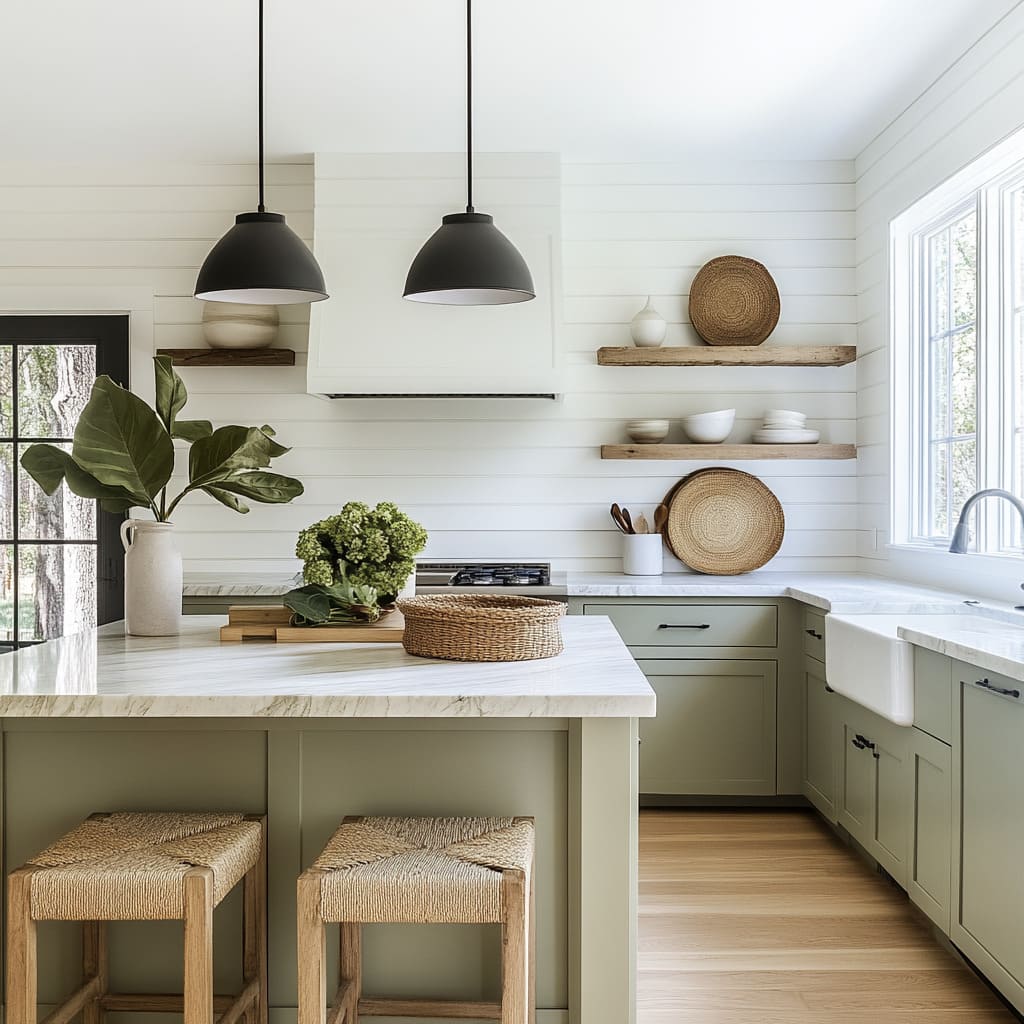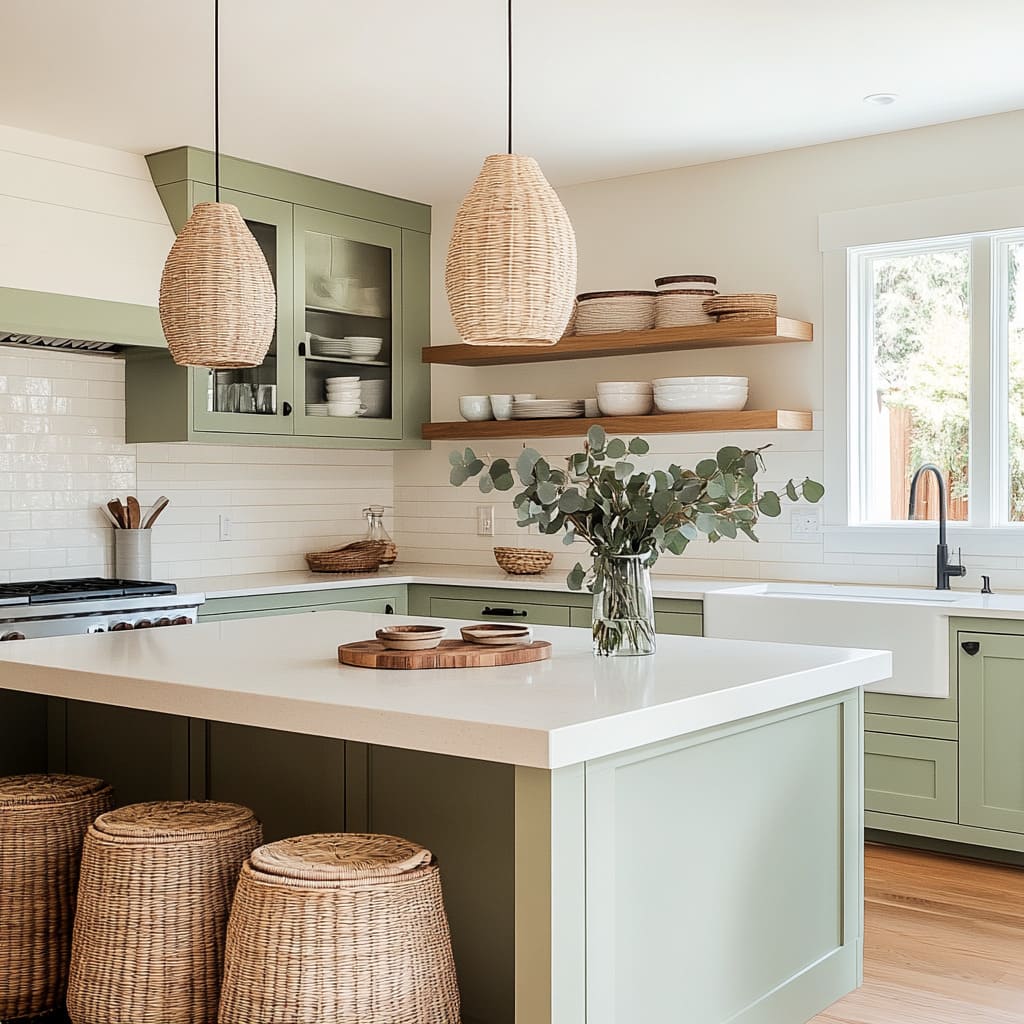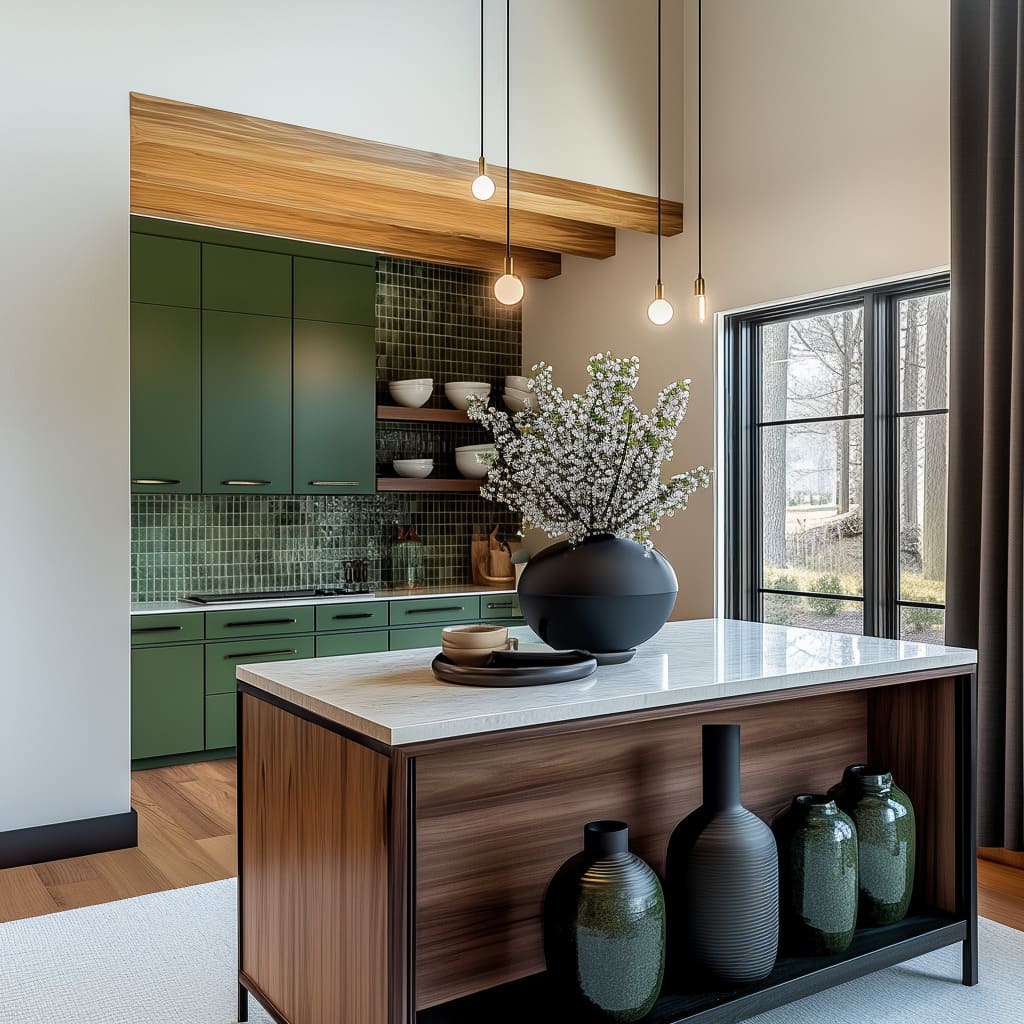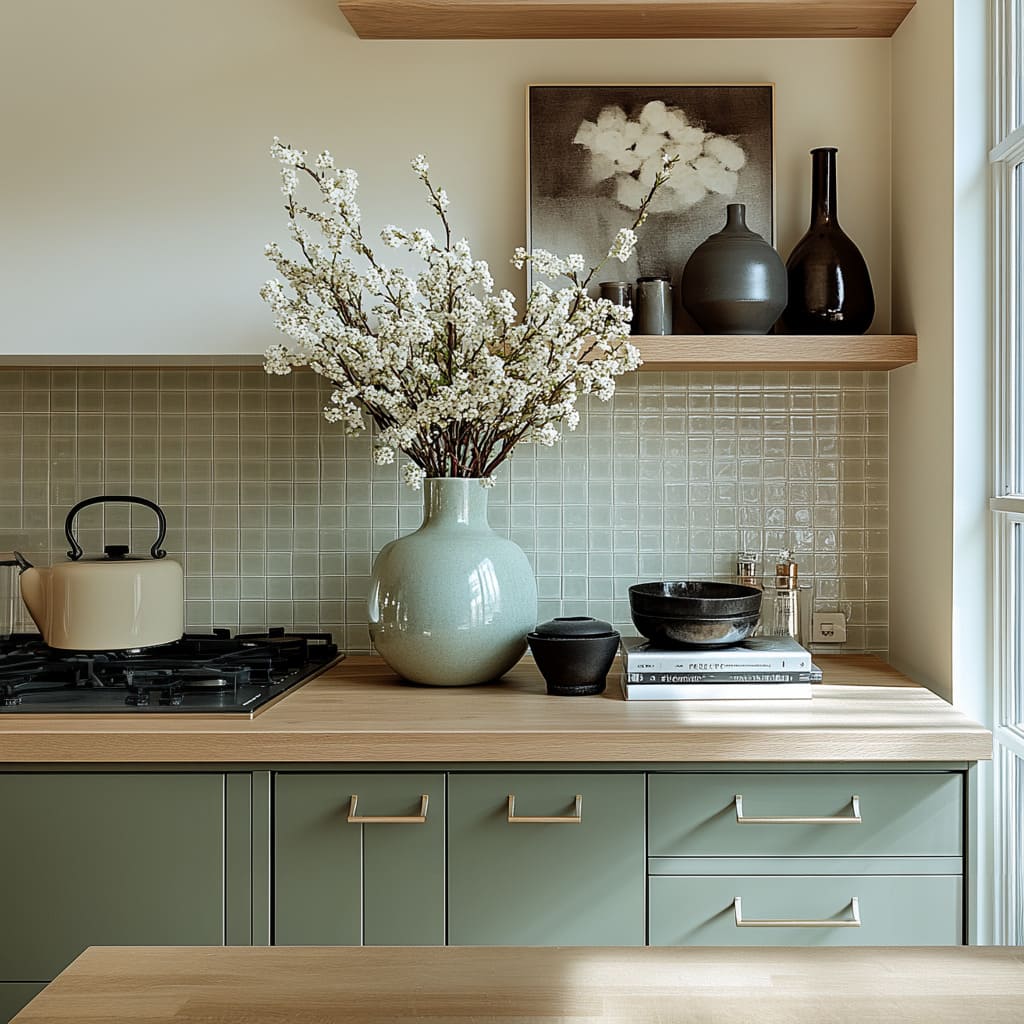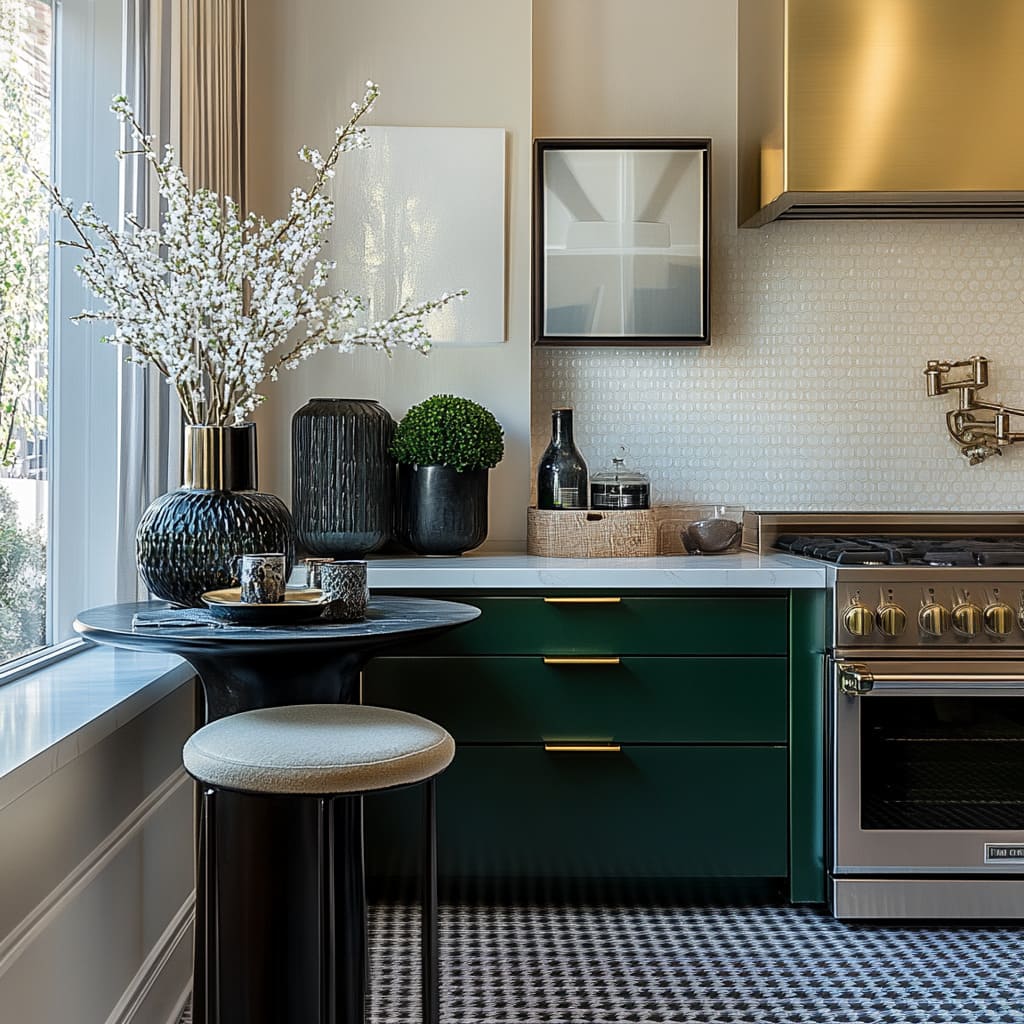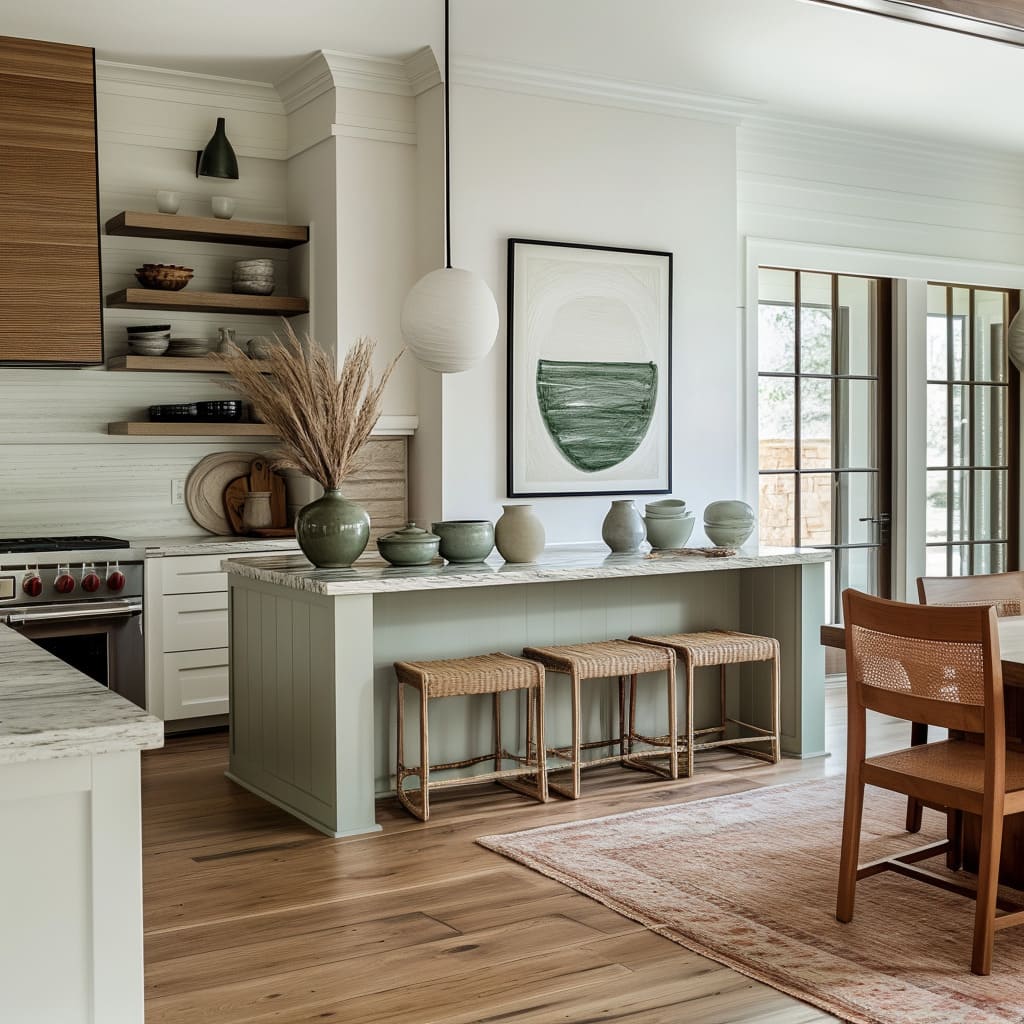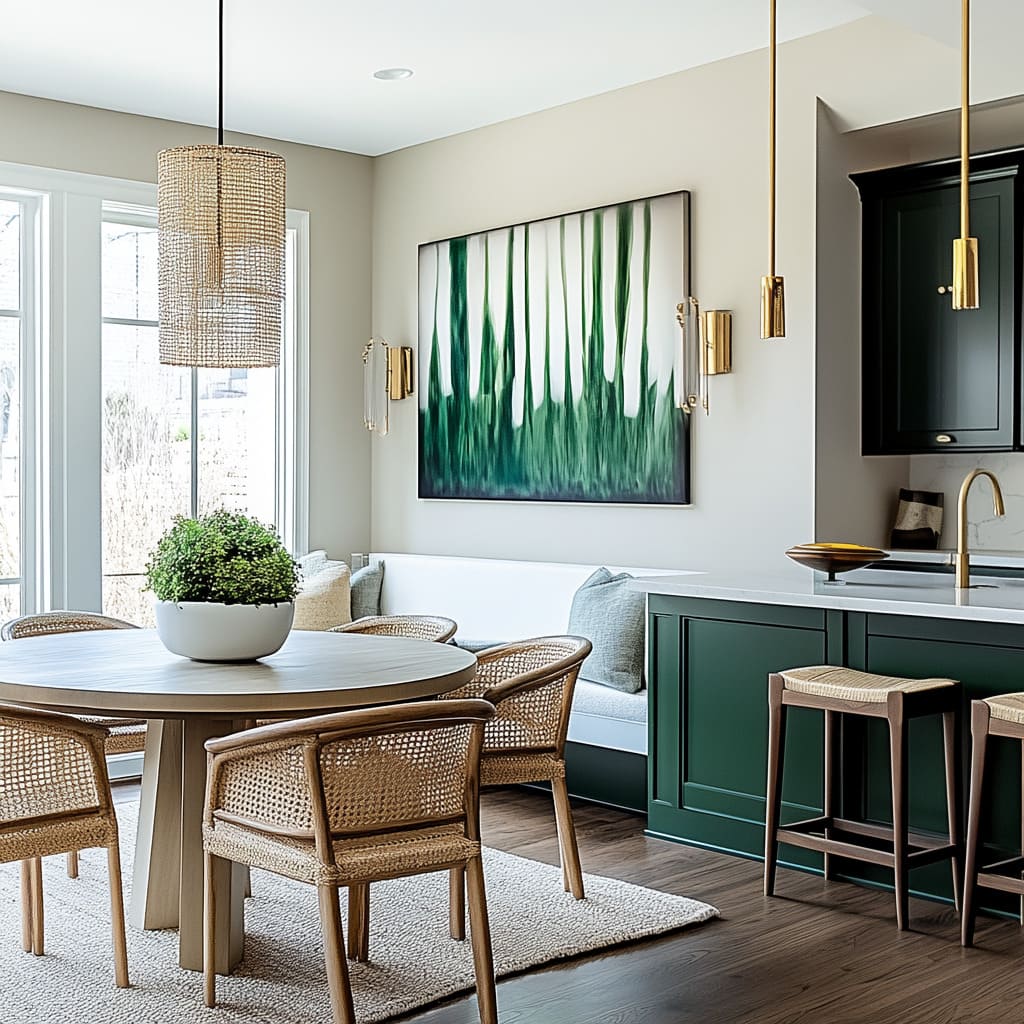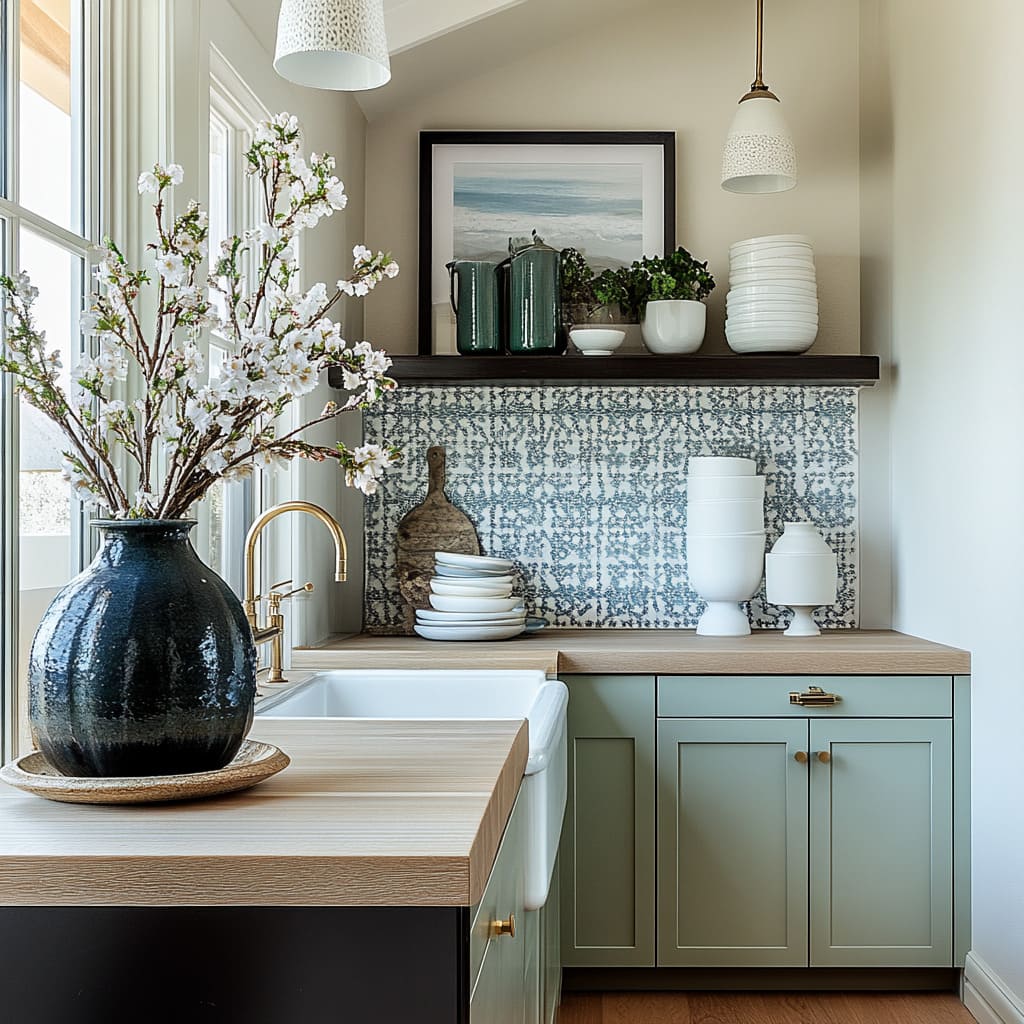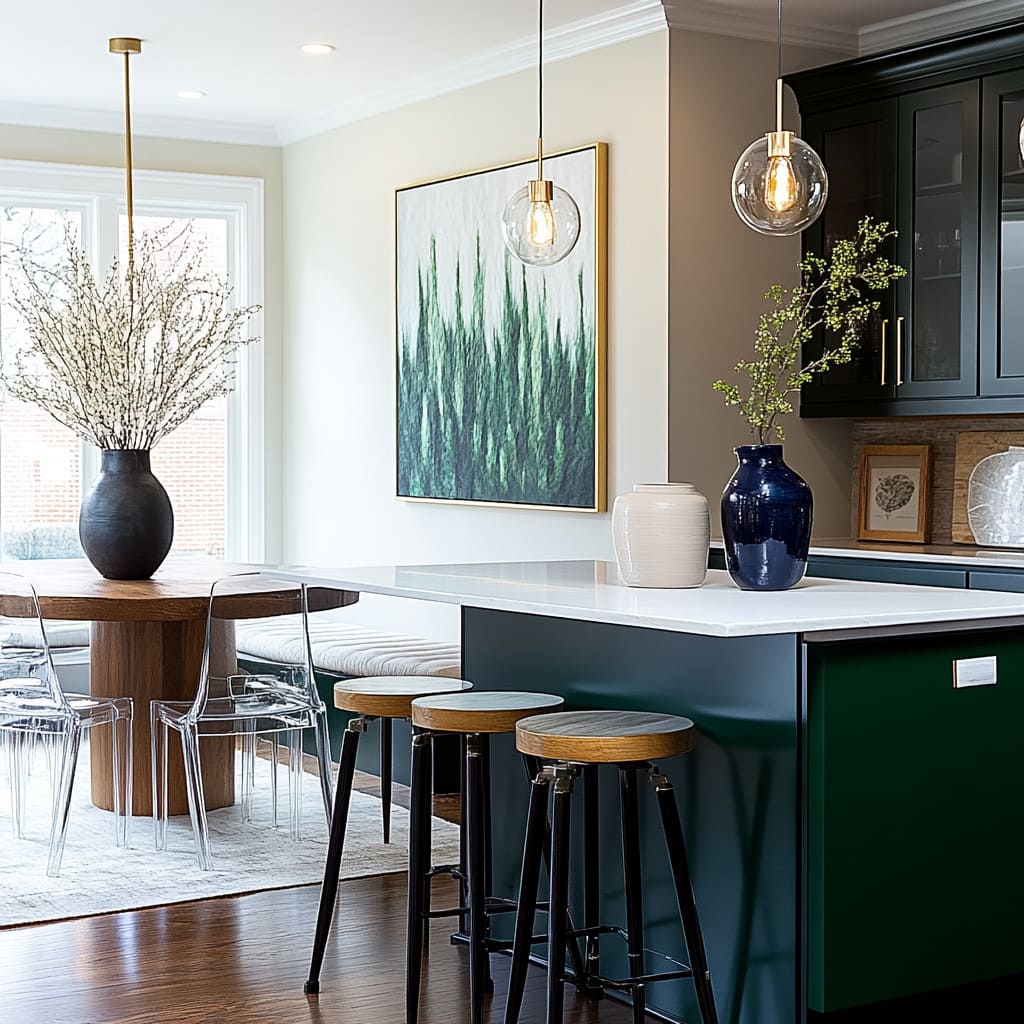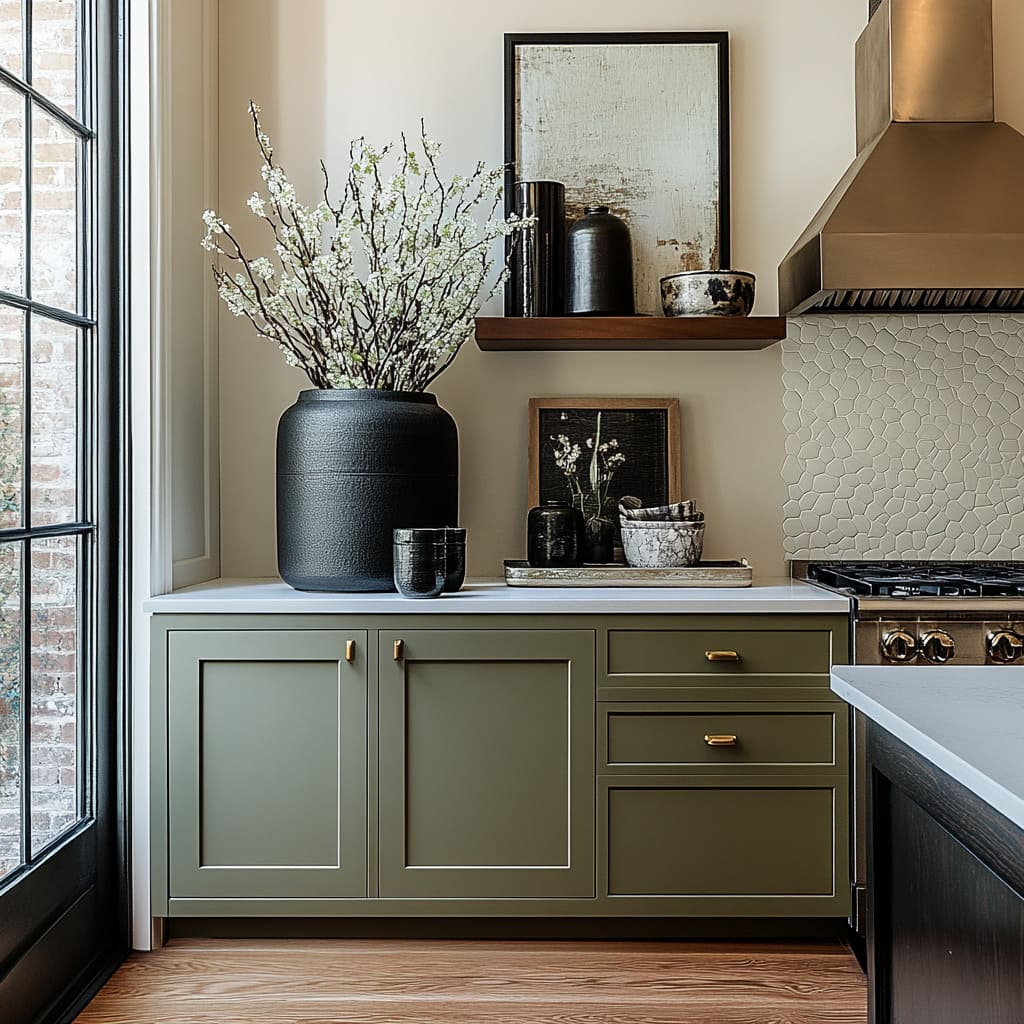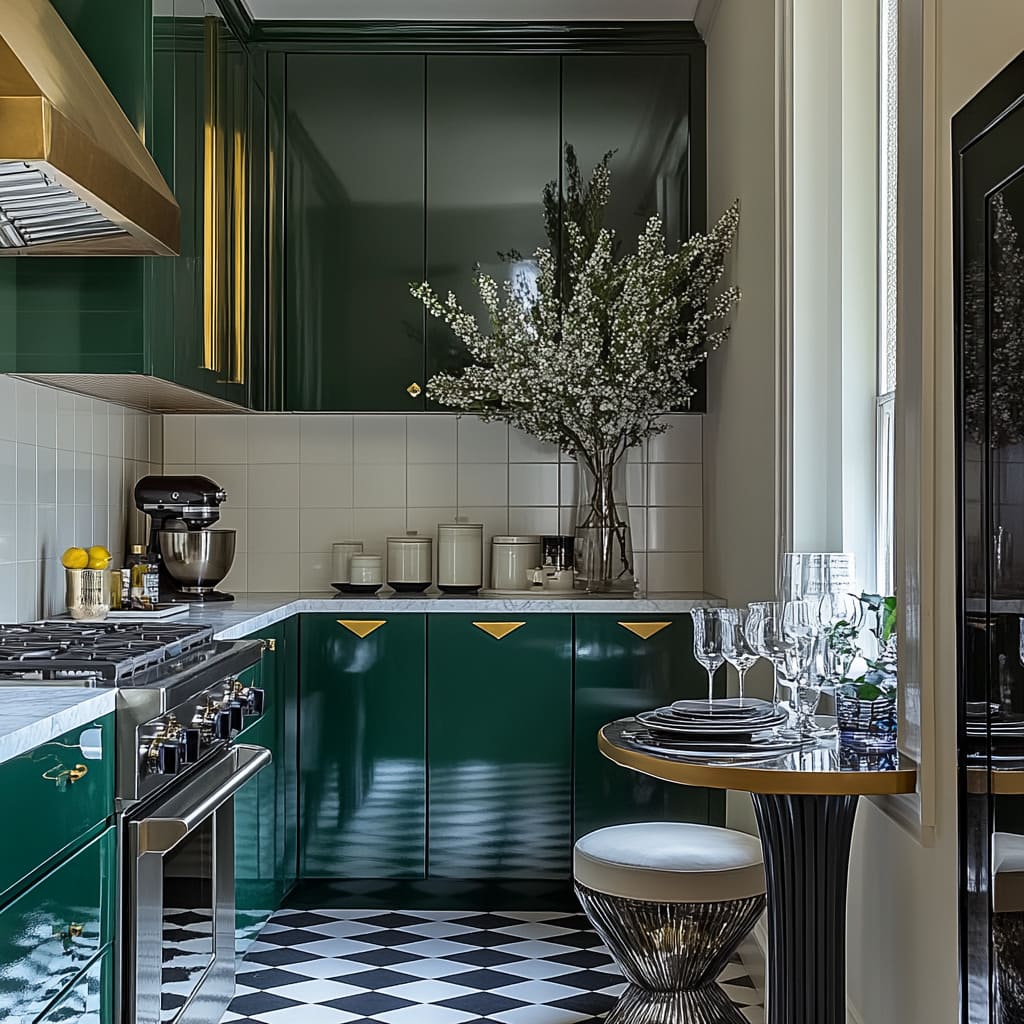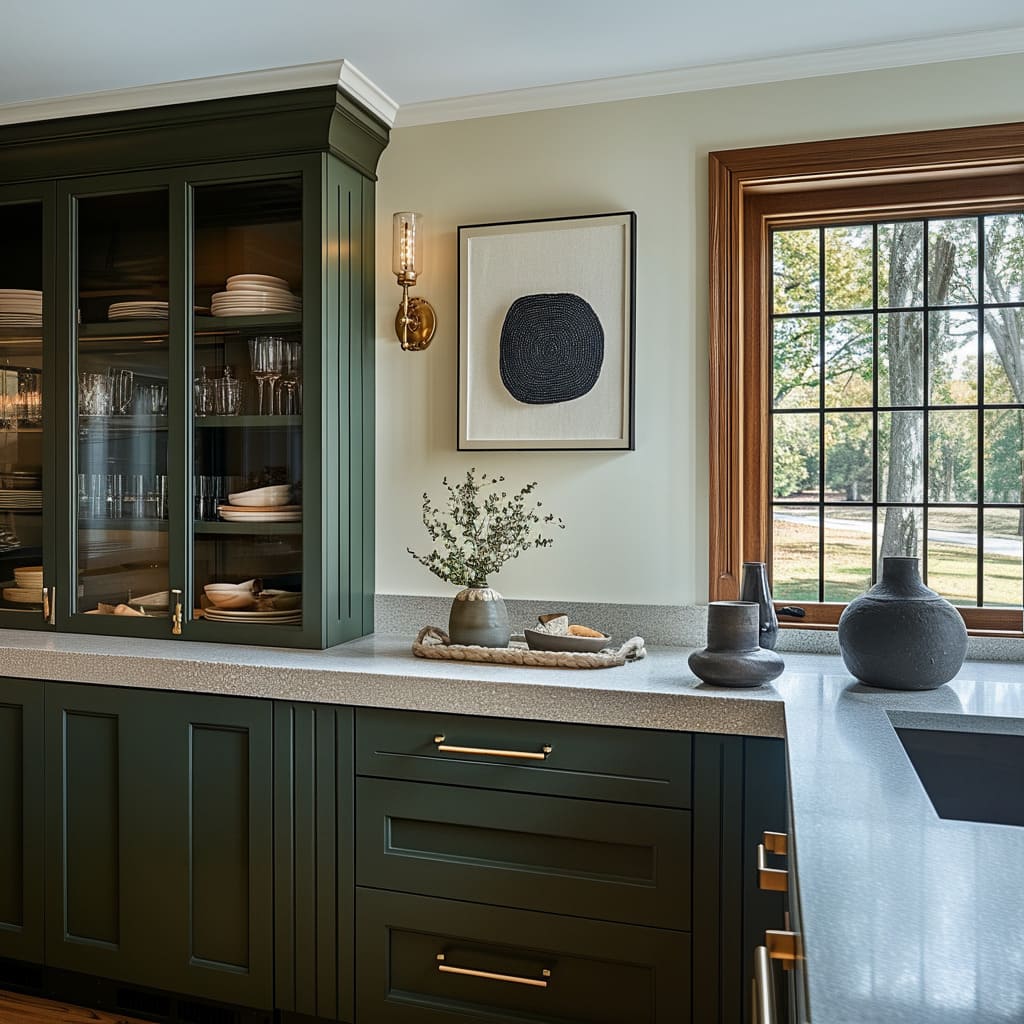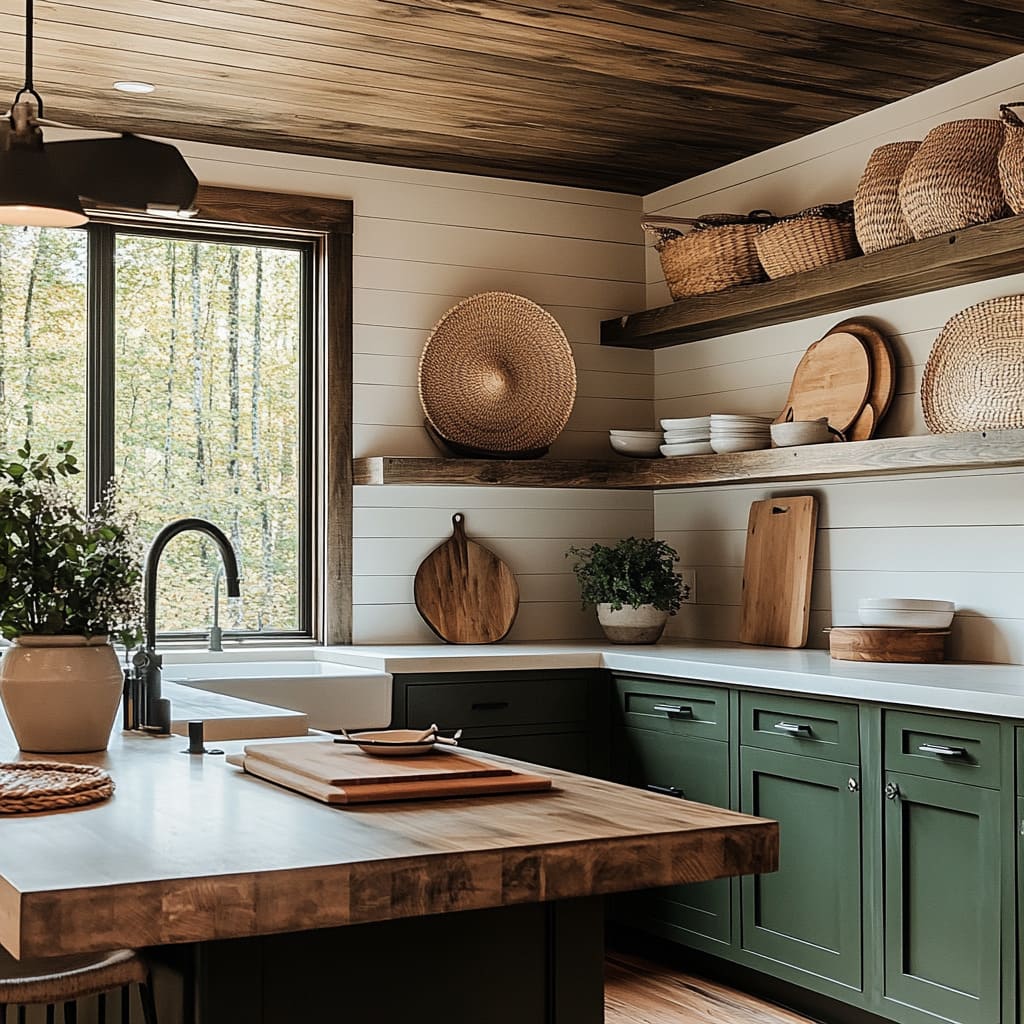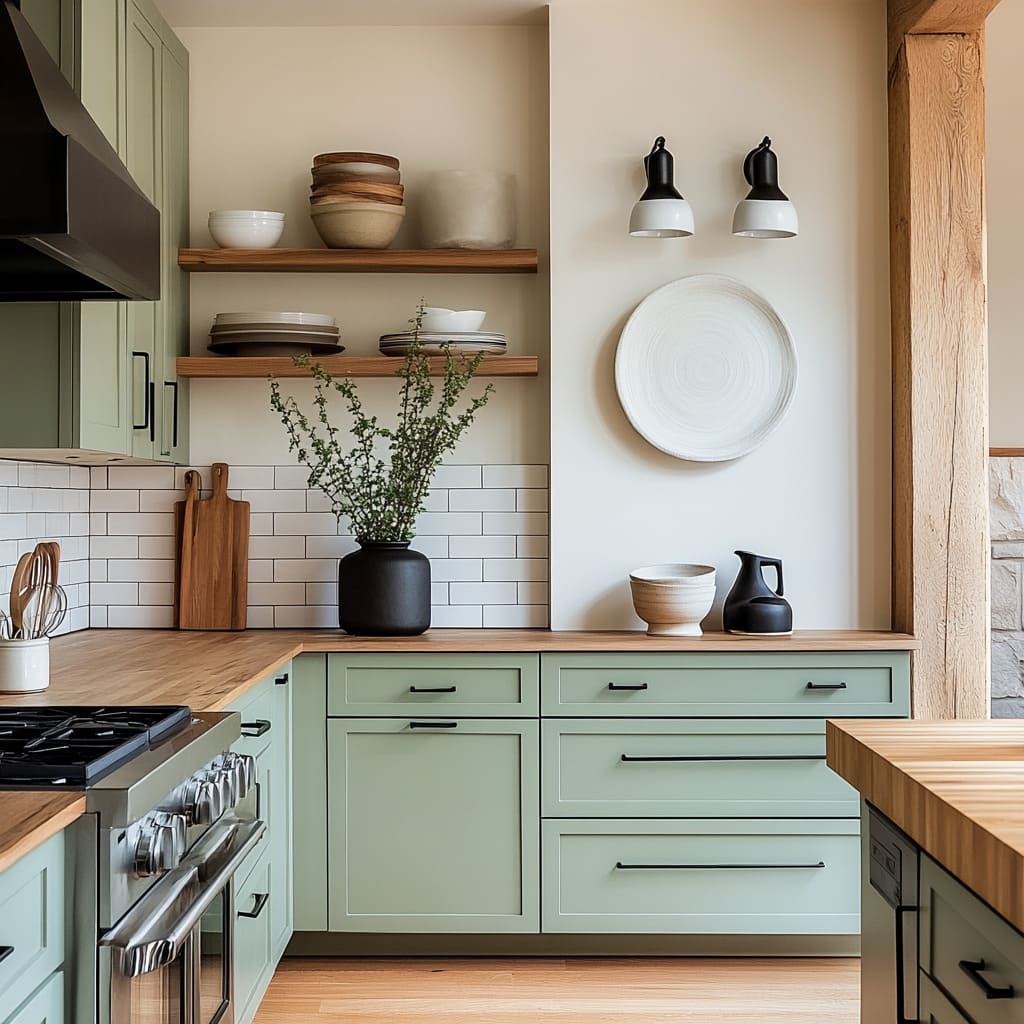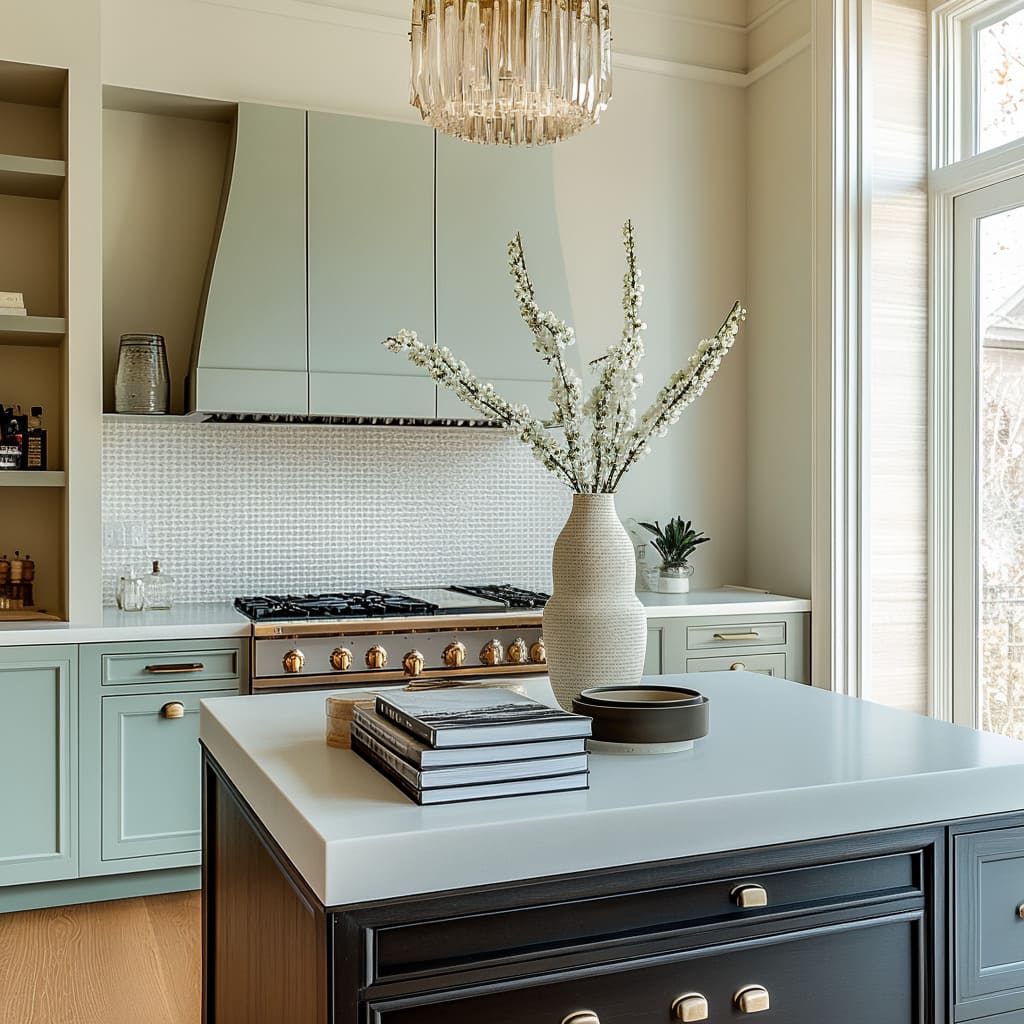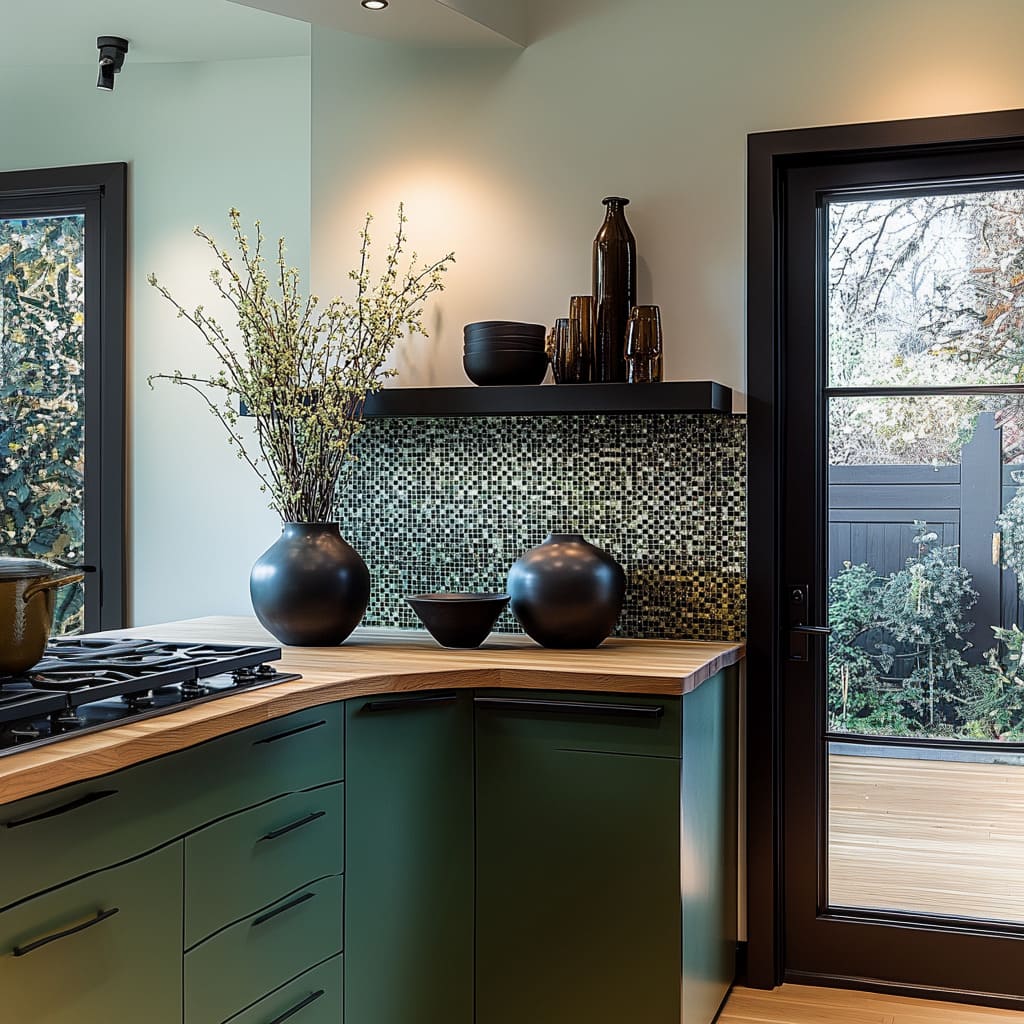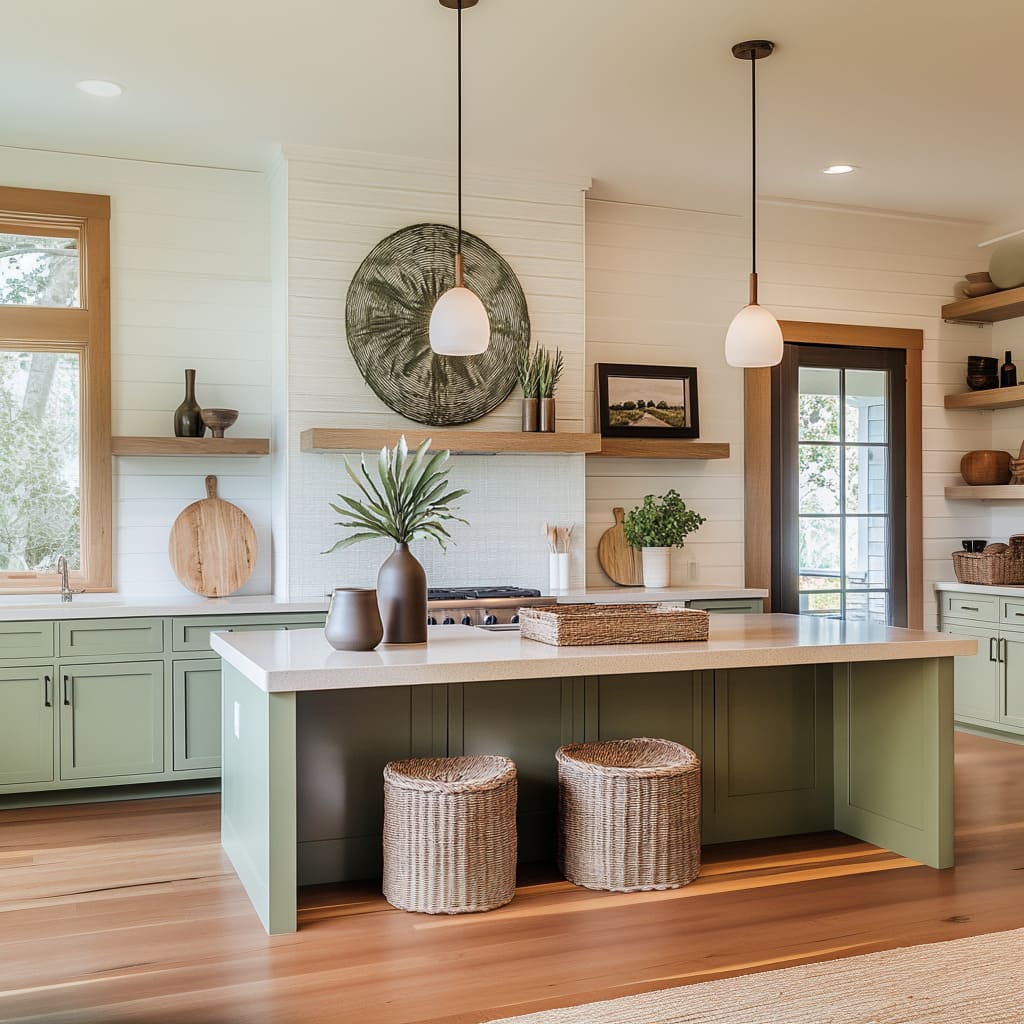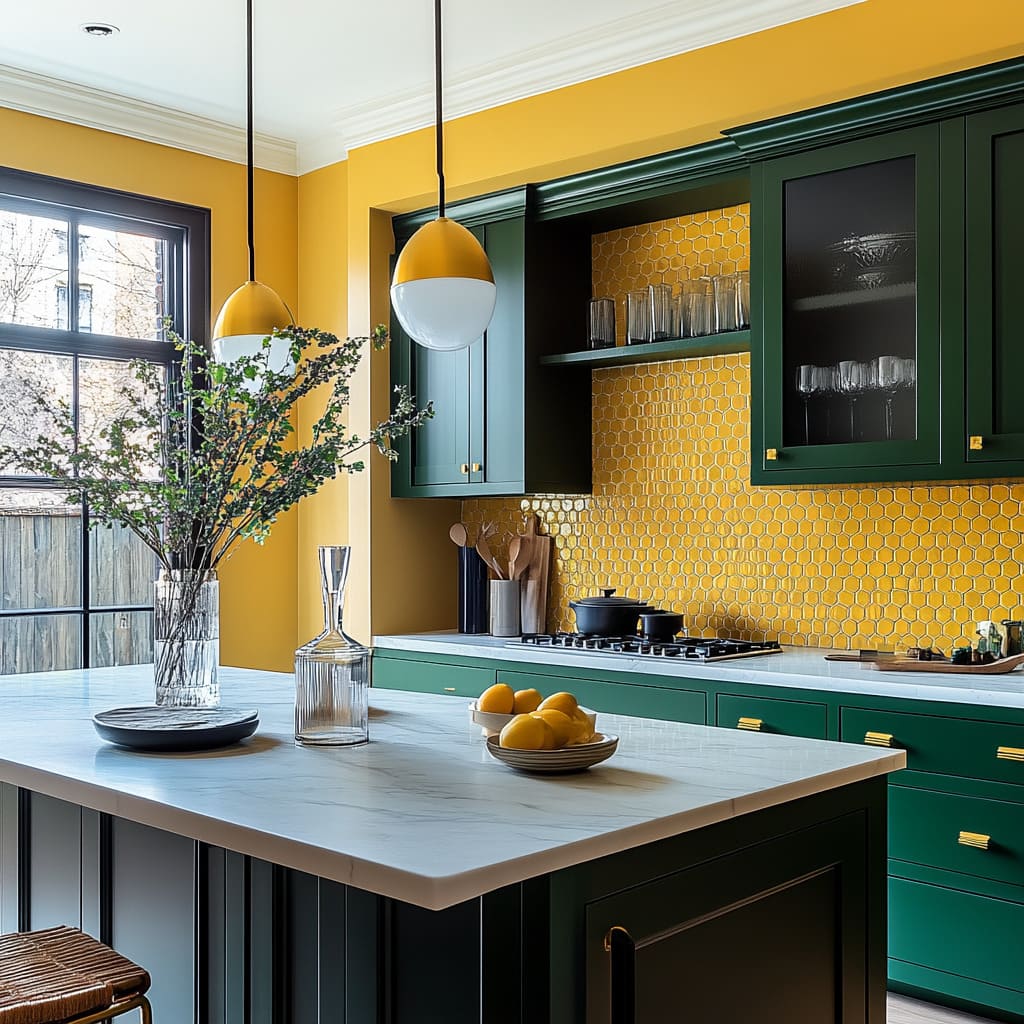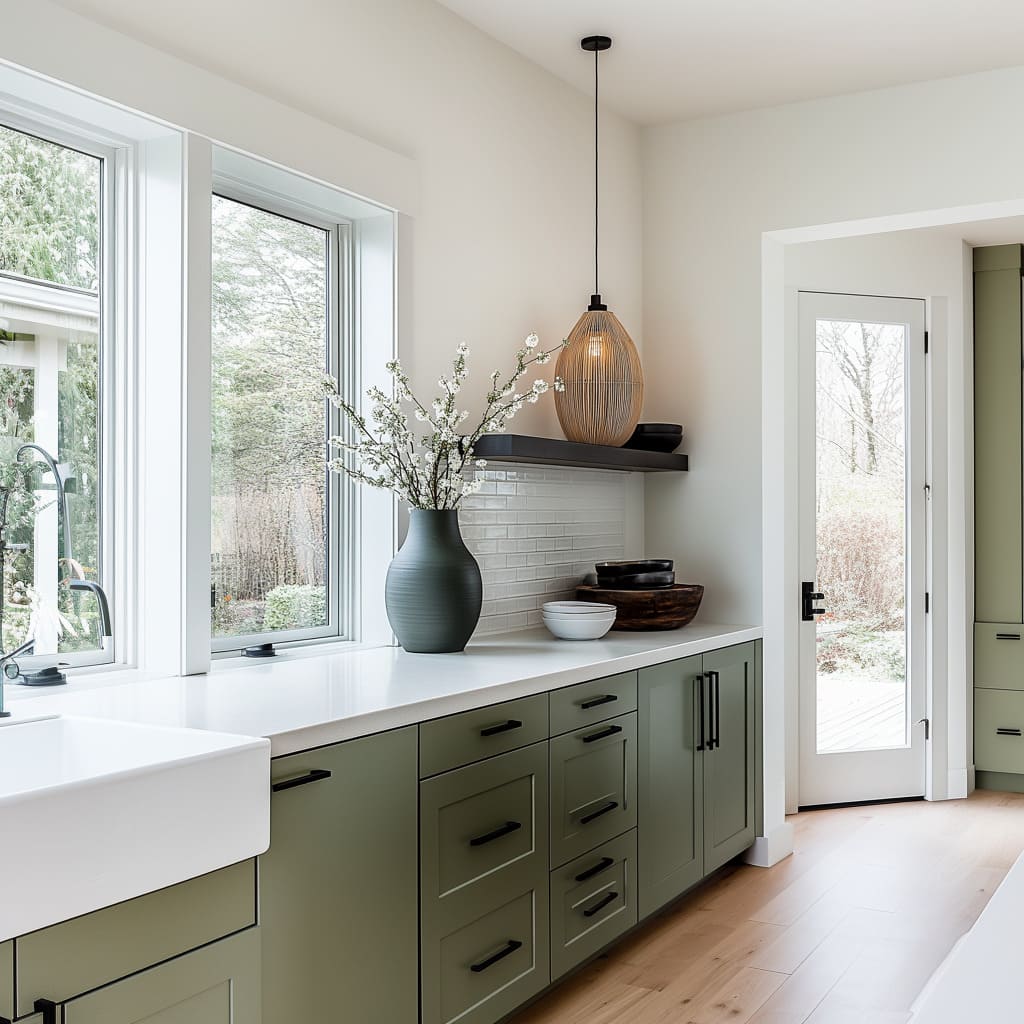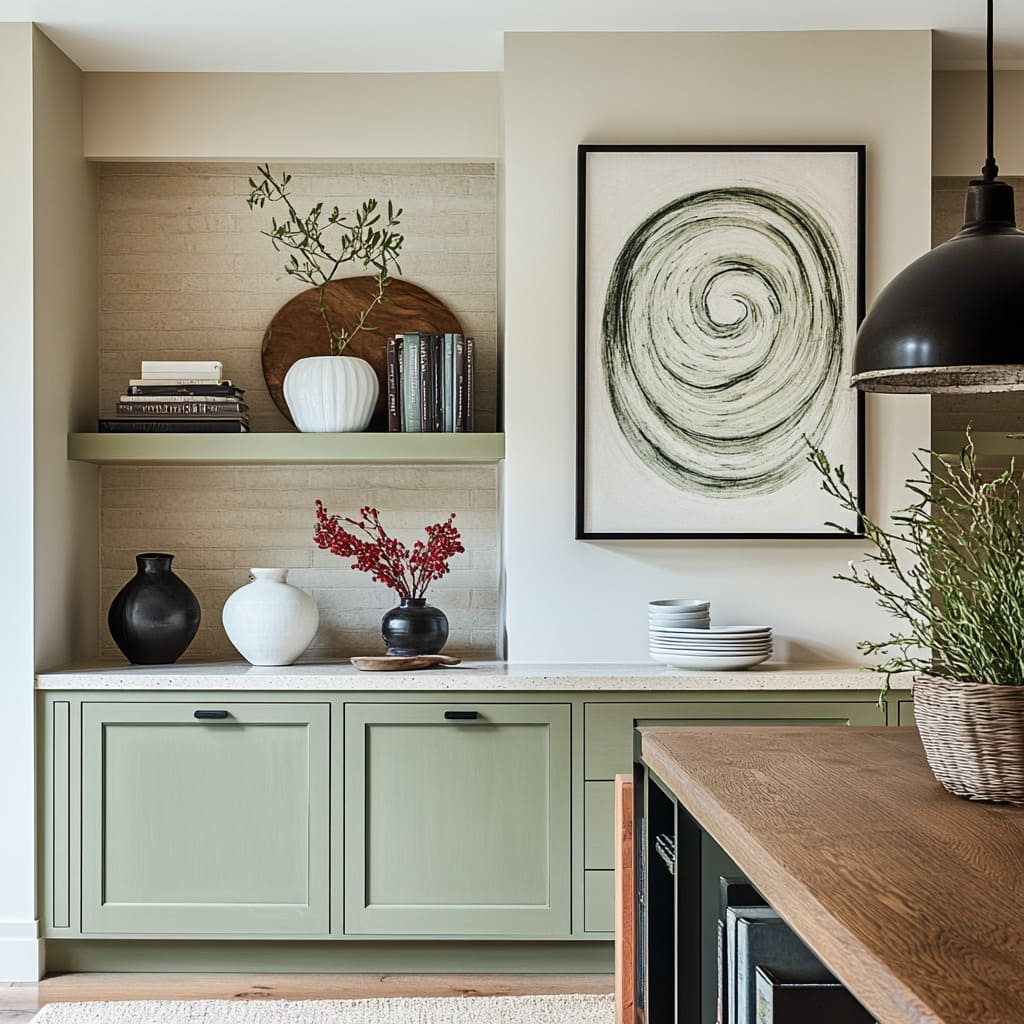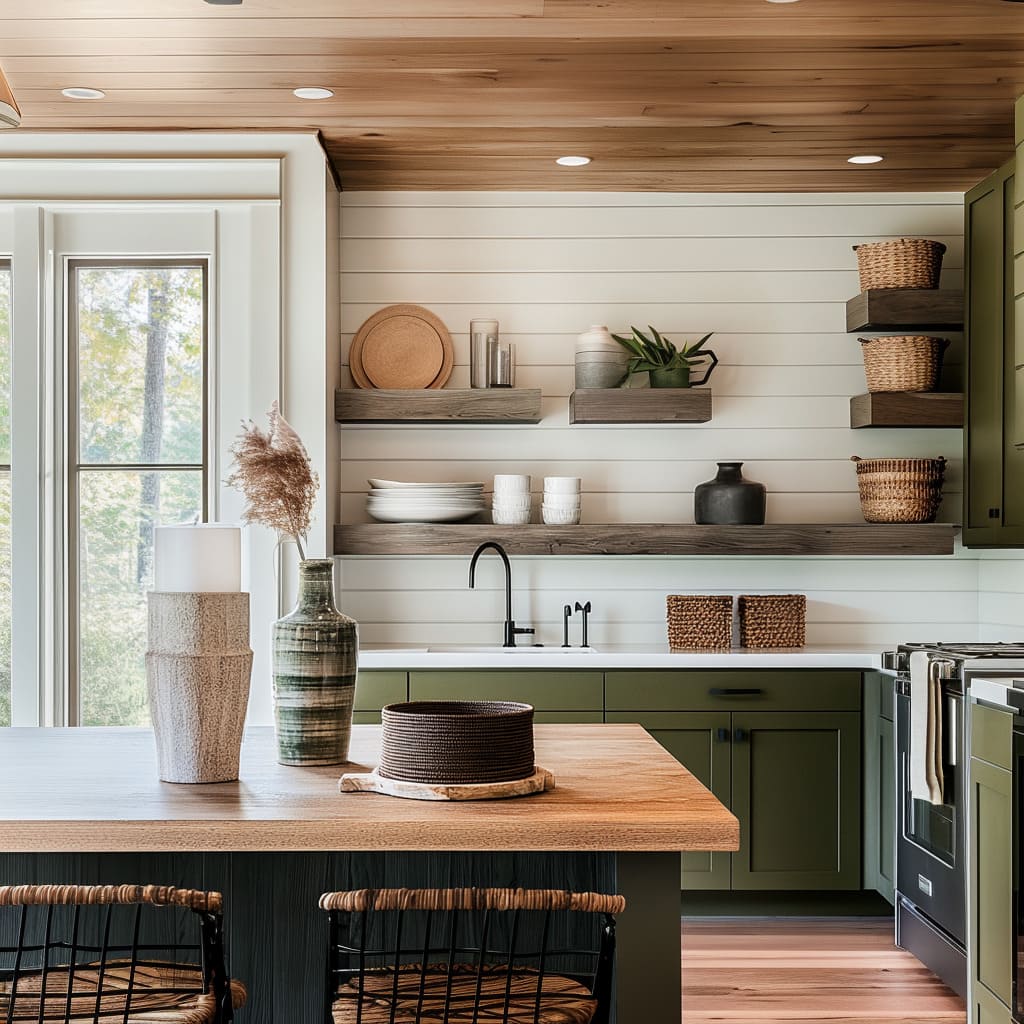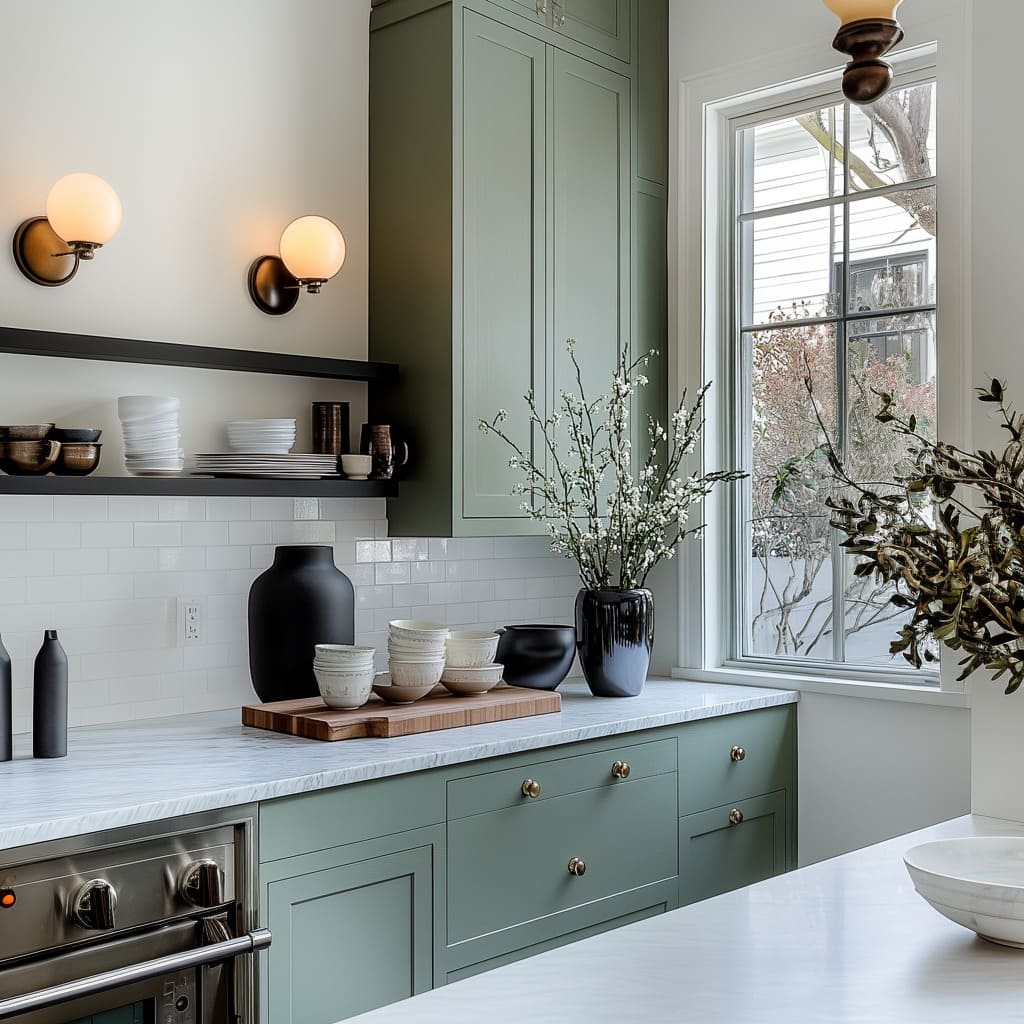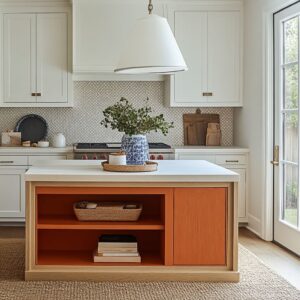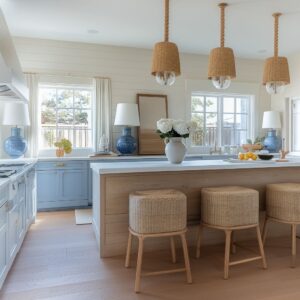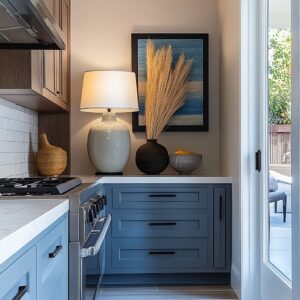Green kitchens are having a moment, and it’s easy to see why. This versatile color offers endless possibilities for creating spaces that feel stylish, inviting, and uniquely personal.
Whether you’re drawn to soft sage tones for a calming touch or bold emerald shades for dramatic flair, green is a choice that stands out in kitchen design. In this article, we’ll explore green color kitchen ideas that combine functionality with stunning aesthetics.
From the perfect shade selection to pairing materials and accessories, you’ll find plenty of inspiration to transform your kitchen into a space that’s as practical as it is visually striking. Let’s dive into the endless ways green can elevate your kitchen’s style and character.
Versatility of Green as a Primary Hue
When it comes to green kitchen design, the color proves itself to be incredibly adaptable, with shades that complement a variety of styles and preferences. Each tone offers a unique personality, making it easy to create a space that feels just right for your home.
Sage green, for example, has a soft, understated character that works wonderfully in kitchens aiming for a connection to nature. Its muted tones lend a calming presence, making it perfect for kitchens with large windows or outdoor views.
For those who love a more dramatic approach, deep forest green stands out with its rich, bold feel. This shade pairs beautifully with metallic hardware like brushed brass or antique gold, offering a striking contrast that feels both luxurious and grounded.
If your vision leans toward a cozy, earthy atmosphere, olive green offers a warm, inviting tone. This shade is particularly popular in spaces that blend contemporary and rustic elements, creating a balanced and approachable aesthetic.
On the other hand, emerald green is a lively and eye-catching choice. It’s ideal for homeowners who want a kitchen that feels modern and glamorous.
Paired with polished brass accents or sleek lighting, this vibrant shade exudes sophistication while maintaining a fresh edge.
The choice of shade plays a significant role in setting the tone for the space. Whether you’re drawn to soft and subtle hues or prefer the energy of bold, saturated greens, your selection can help define the mood and overall feel of the kitchen.
For a tranquil vibe, go with lighter tones, while deeper greens can create a sense of richness and depth. By understanding how green works within different styles and finishes, you can create a design that reflects both your taste and your home’s character.
The versatility of green ensures that it can fit into any kitchen design concept, from modern minimalism to rustic charm.
Layered Color Combinations and Palettes
What makes green kitchens so visually appealing is the thoughtful layering of colors that enhances their charm and individuality. The ability to mix and match tones creates a dynamic and harmonious look, showcasing how versatile green can be when paired with complementary shades and textures.
A classic combination is green with white or cream, which serves as a timeless foundation. The light base softens the green, creating a bright, airy feel perfect for kitchens that aim for openness and freshness.
This pairing is particularly effective in homes with natural light, as the contrast accentuates the brightness.
For a more dramatic edge, adding dark accents like black shelves, hardware, or window frames introduces depth and contrast. These darker elements ground the design and balance the lighter tones, ensuring the space feels cohesive without being overly bold.
When it comes to adding warmth and a hint of luxury, gold and brass finishes work seamlessly, especially with deeper green tones. Whether it’s cabinet handles, light fixtures, or faucets, these metallic touches elevate the overall look and add sophistication without feeling overpowering.
To bring in a natural, grounded vibe, neutral tones such as beige, taupe, or light wood are excellent choices. These subtle hues pair beautifully with green, offering a harmonious backdrop that doesn’t compete for attention.
For example, light wood flooring or shelves can soften the overall look, making the space feel inviting and balanced.
The beauty of these combinations lies in their flexibility. Whether you’re going for a minimalist look or a richly layered design, the key is to think about how colors interact.
By layering green with complementary tones, you can add visual interest and ensure your kitchen feels curated and complete. If you’re looking for fresh green kitchen ideas, consider mixing green with metallic details for a touch of glamour or pairing it with wood for a more organic, earthy feel.
These thoughtful combinations create a kitchen that not only looks beautiful but also feels cohesive and personal to your style.
Contrasts in Textures and Materials
One of the most effective ways to elevate a green kitchen design is by introducing contrasts in textures and materials. This approach not only enhances the visual appeal but also adds depth and character to the space, creating a balanced and engaging environment.
Smooth surfaces, like marble or quartz countertops, are a classic choice that instantly lends a polished and refined feel. These materials, with their sleek finishes, complement the boldness of green tones while ensuring a sophisticated aesthetic.
They also serve as a clean canvas for layering other textures throughout the space.
In contrast, matte finishes on green kitchen cabinets soften the overall look, striking a balance between modern and inviting. The subdued finish prevents the design from appearing too clinical or overly glossy, making the space feel approachable yet stylish.
Matte cabinetry is particularly effective when paired with natural light, as it reduces glare and enhances the depth of color. To break up the monotony and add a touch of personality, textured backsplashes such as mosaics, subway tiles, or handcrafted ceramic tiles can be introduced.
These intricate patterns and finishes subtly draw the eye, creating a point of interest without overwhelming the design. The texture contrasts beautifully with the smoothness of countertops and the uniformity of cabinetry.
Wooden elements, like butcher block countertops or open shelving, infuse the kitchen with a sense of warmth and tactility. The organic texture of wood contrasts with the cooler tones of green, resulting in a balanced mix of earthy and modern aesthetics.
Whether light or dark, wood adds a timeless quality that complements various styles, from contemporary to rustic. By layering these elements, a dynamic and visually rich kitchen is achieved.
Imagine pairing smooth marble counters with a backsplash that features textured tiles, while matte green cabinetry ties it all together. The interplay of these materials ensures that no single element dominates, creating a cohesive and thoughtfully designed space.
Whether your style leans modern or rustic, blending smooth, matte, and textured finishes offers endless possibilities. If you’re aiming for a trendy look, consider pairing green kitchen cabinets with a textured backsplash and warm wood accents to create a design that feels both timeless and fresh.
Thoughtful Lighting Integration
Lighting is an essential component in any kitchen, and its influence becomes even more pronounced in spaces with green cabinets. The way light interacts with green tones can transform the mood, highlight design details, and create an inviting ambiance.
Integrating a mix of lighting styles ensures that both functionality and aesthetics are perfectly balanced. Pendant lights positioned over kitchen islands or counters bring both practicality and visual interest.
These fixtures often double as standout features, particularly when designed with glass or metallic elements. Their reflective finishes not only distribute light evenly but also enhance the shine of green cabinetry, adding a touch of sophistication to the overall design.
For a more focused glow, wall sconces can be placed above shelves or countertops. These lights create defined areas that feel intimate and purposeful, drawing attention to specific details, like a beautifully styled shelf or a carefully chosen backsplash.
The interplay of shadow and light from sconces further emphasizes the depth of green tones, giving the kitchen a warm and layered feel. Natural light, maximized through large windows or open layouts, is perhaps the most effective way to bring out the richness of green cabinets.
Sunlight streaming through a well-placed window enhances the texture and color variations in the cabinets, while also making the space feel fresh and open. For kitchens with smaller windows, reflective surfaces like glossy tiles or light countertops can help distribute natural light more effectively.
The key is layering these lighting elements to suit different needs throughout the day. Pendant lights provide central illumination, sconces add accent lighting, and natural light ties it all together for a balanced ambiance.
The thoughtful combination of these sources allows the green tones in the kitchen to shine without overpowering the space. When designing a kitchen with green cabinets, think of lighting as an integral part of the design palette.
Use pendant lights to anchor the space, sconces to create character, and natural light to breathe life into the room. The result is a space that feels harmonious, practical, and undeniably stylish.
Hardware and Accessories as Design Accents
When it comes to crafting a standout green kitchen, the choice of hardware and accessories can make all the difference, subtly enhancing the design while adding layers of personality. These small yet impactful elements serve as finishing touches that tie the space together and elevate the overall aesthetic.
Gold and brass handles are a popular choice in green kitchen designs, bringing warmth and an understated sense of sophistication. These finishes beautifully complement deeper greens, such as forest or emerald shades, creating a luxurious and cohesive look.
The reflective quality of these metals also helps bounce light around the room, softening the richness of green tones without dulling their presence.
On the other hand, black hardware introduces a contemporary, minimalist edge. Against lighter greens like sage or olive, black handles and knobs create a bold contrast that feels clean and modern.
This combination works particularly well in kitchens that lean toward Scandinavian or industrial-inspired aesthetics, where simplicity is key. Accessories are another opportunity to subtly amplify the beauty of green kitchen decor.
Thoughtfully placed vases, ceramics, or framed artwork can enhance the room’s palette without overwhelming it. For instance, a ceramic vase with earthy textures or artwork featuring complementary tones like beige, gold, or even muted blues can highlight the natural richness of green cabinetry.
When layering these details, balance is critical. Metallic finishes—whether warm like brass or cool like black—should be deliberate choices that align with the kitchen’s overall mood.
Similarly, accessories should feel purposeful, acting as cohesive design accents rather than clutter. Even something as simple as a well-curated shelf with a few pieces of pottery or a modern sculpture can transform a functional kitchen into an inviting and stylish space.
Ultimately, incorporating thoughtful hardware and decor into your green kitchen decor is about enhancing the aesthetic with intention. Whether you’re aiming for a polished and sophisticated vibe with brass finishes or a more contemporary look with black accents, these elements ensure your kitchen is as practical as it is visually striking.
Open Shelving for Style and Functionality
Open shelving is a design choice that merges style with practicality, offering a fresh alternative to traditional cabinetry. Many green kitchen designs incorporate this feature, emphasizing its ability to balance aesthetics and functionality while enhancing the overall appeal of the space.
Light wood shelves are a standout choice, particularly when paired with green cabinets. They introduce an organic element that complements the green tones, creating a sense of warmth and grounding the space.
This pairing works especially well with lighter shades like sage or olive, where the natural wood can subtly enhance the softness of the color palette.
One of the greatest advantages of open shelving is the opportunity for curated displays. Beautifully arranged ceramic pieces, small potted plants, or neatly stacked kitchenware can transform a purely functional area into a personalized design statement.
These elements not only add texture but also provide an easy way to weave in complementary colors or materials that echo other parts of the kitchen’s design. From a spatial perspective, open shelving introduces visual breaks, which are particularly important in kitchens with a lot of cabinetry.
By eliminating some upper cabinets and replacing them with open shelves, the kitchen feels more spacious and inviting rather than closed-off or heavy. This is a key consideration when working with darker greens, as the open shelving ensures the space doesn’t feel weighed down by color intensity.
However, achieving a balanced look with open shelving requires restraint. Using these shelves sparingly ensures that the kitchen remains organized and avoids visual clutter.
A handful of well-chosen items can go a long way in creating an effortlessly stylish look without overwhelming the design. Finally, open shelving can also serve as a way to experiment with different shades and finishes.
When paired with the best green for kitchen cabinets, whether it’s a subtle sage or a dramatic emerald, these shelves create a harmonious balance between utility and style. Their versatility allows them to adapt to both modern and traditional settings, making them a timeless feature in any kitchen.
Incorporating open shelving into a green kitchen design is about more than just functionality—it’s about using every element to enhance the space’s overall character and charm. When thoughtfully styled, these shelves add a layer of personality that’s hard to achieve with closed cabinetry alone.
Bold Backsplash Choices
In any well-designed kitchen, the backsplash serves as more than just a protective layer—it’s an opportunity to make a striking visual statement. Green kitchens in particular lend themselves beautifully to creative backsplash designs, as the color pairs effortlessly with a variety of materials, patterns, and finishes.
Mosaic tiles are a popular choice, especially when done in white or metallic tones. These small, intricate tiles create texture and reflect light, adding brightness to the space.
When paired with rich green kitchen units, the result is a balanced look that feels both fresh and sophisticated. Metallic mosaics, such as brushed gold or silver, are particularly effective in accentuating the warmth of brass or gold hardware.
For a contemporary feel, subway tiles remain a classic option, but with a twist. Arranging them in a vertical stack or a herringbone pattern adds a layer of modernity to this timeless design.
When used with muted greens like sage or olive, these patterns create a subtle contrast, adding depth without overwhelming the overall aesthetic. If you’re looking to make an even bolder statement, hexagonal tiles or intricate patterns are a standout choice.
These geometric designs introduce a playful element that can bring life to a minimalist kitchen. Dark green cabinetry paired with a bold, patterned backsplash creates a dramatic yet cohesive look, especially when balanced with neutral countertops.
The key to selecting the right backsplash is ensuring it complements the surrounding elements. It should enhance the beauty of the green kitchen units while harmonizing with the countertops and other finishes.
Whether you choose textured mosaics, reimagined subway tiles, or daring patterns, the backsplash can be a defining feature of your kitchen’s design. Ultimately, the backsplash serves as a canvas for creativity, offering endless possibilities to personalize your space.
By thoughtfully pairing materials, colors, and textures, you can transform this functional element into a highlight of your kitchen’s design.
Creative Use of Furniture and Accessories
Incorporating thoughtfully chosen furniture and accessories into your kitchen design can elevate the overall aesthetic while maintaining functionality. These elements serve as a bridge between practicality and style, especially when working with green cabinets for kitchen spaces.
A standout feature in many designer kitchens is the use of kitchen islands painted in complementary or contrasting tones. For example, pairing deep green cabinetry with a soft cream or natural wood island creates a striking visual anchor in the space.
This contrast helps define areas in open layouts, adding both structure and interest to the overall design.
Seating choices, such as bar stools in natural materials, play a crucial role in softening the room’s appearance. Rattan, cane, or unfinished wood stools not only add texture but also introduce warmth that beautifully offsets the cool tones of green cabinets.
This combination feels approachable yet refined, making the kitchen a welcoming space for family and guests. Accessories like artwork and small decor items further enhance the design by tying together various elements.
Choosing pieces in neutral or monochromatic tones ensures the accessories don’t compete with the green palette but instead complement it. Ceramic vases, subtle framed prints, or woven baskets can bring depth and personality to the space while maintaining a cohesive look.
By blending practical furniture and decor with deliberate design choices, you can create a harmonious and visually appealing kitchen. The key lies in balancing contrasting textures and tones—soft natural materials, bold painted islands, and curated accessories work together to bring out the best in green cabinets for kitchens.
With these details, the space feels both purposeful and stylish, perfect for any modern home.
Maximizing Natural Light and Layouts
A well-designed kitchen is as much about its layout and lighting as it is about its color palette. When working with kitchen sage green cabinets, the interplay of light and spatial flow becomes especially critical to enhancing the room’s aesthetic and functionality.
Large windows are an undeniable asset in any kitchen. They allow natural light to flood the space, bringing out the soft, earthy undertones of sage green.
The sunlight not only keeps the kitchen feeling fresh and inviting but also highlights the subtle variations in cabinet finishes, adding depth and texture to the design.
In tighter layouts like galley kitchens, reflective surfaces can make a world of difference. Glossy tiles or light-colored countertops amplify light, creating the illusion of a more expansive space.
When paired with sage green cabinets, these surfaces add a layer of brightness that prevents the room from feeling enclosed or overly dark. Open layouts, on the other hand, prioritize connectivity and flow, making them ideal for kitchens that double as gathering spaces.
The airy feel of an open design is enhanced by sage green cabinetry, which balances the room with a natural, calming tone. The placement of key elements, such as an island or dining table, should encourage easy movement while maintaining the kitchen’s functionality.
Reflective materials, strategically placed lighting, and thoughtful layouts work together to ensure the space feels both practical and visually striking. By maximizing natural light and optimizing the layout, your sage green kitchen can achieve the perfect balance of style and usability, whether it’s a compact galley design or a spacious, open-plan area.
Flooring that Complements Green
Flooring plays a vital role in anchoring the overall aesthetic of a kitchen, especially when working with green cabinetry. The right choice can either enhance the room’s balance or create bold contrasts, making it a key component in the design process.
Light oak flooring is a popular choice for kitchens featuring darker green cabinetry. Its warm tones soften the intensity of deep greens like forest or emerald, creating a harmonious blend that feels both grounded and inviting.
This pairing works well in both traditional and modern settings, adding warmth without overwhelming the room.
For those seeking a more dramatic approach, bold patterned tiles can be an exciting option, particularly under islands or in smaller kitchens. Patterns like geometric designs or encaustic-style tiles introduce energy and movement to the space, acting as a focal point without detracting from the green cabinetry.
These tiles are especially effective in kitchens where the rest of the design leans minimal, as they add an extra layer of personality. In contrast, neutral and understated flooring options, such as herringbone wood, are ideal for creating a seamless and cohesive look.
These subtle patterns complement earthy green tones, such as sage or olive, without drawing too much attention. Herringbone patterns, in particular, add visual texture and depth while maintaining an overall understated elegance.
The key to choosing the perfect flooring lies in balancing the intensity of your green cabinetry. If your cabinets are bold and eye-catching, opt for neutral flooring to let them shine.
Conversely, if your cabinetry features softer shades, bolder flooring can add character and prevent the space from feeling flat. Ultimately, your flooring choice should work in harmony with your cabinetry and other design elements, creating a kitchen that feels complete and well-considered.
Whether you prefer the warmth of wood or the statement of patterned tiles, your flooring can tie the entire design together beautifully.
Integration of Nature
Bringing nature into the kitchen is a design approach that not only enhances the beauty of green tones but also creates a warm and inviting atmosphere. By incorporating natural elements, green kitchens feel more connected to the outdoors, adding depth and character to the space.
Indoor plants are a simple yet impactful way to echo the green theme. From potted herbs on the countertop to larger leafy plants in corners, greenery introduces vibrancy and a sense of freshness.
Plants also add a dynamic layer of texture, complementing the smooth surfaces of cabinetry and countertops. Wooden details, whether in exposed beams, open shelving, or furniture, further reinforce an organic feel.
The natural grain and warmth of wood balance the coolness of green tones, creating a harmonious contrast. Light woods pair beautifully with softer greens like sage, while darker woods add richness to deeper green hues, such as forest or emerald.
This integration of natural materials works well across a variety of styles, from modern kitchens with minimalist wood accents to rustic designs featuring more substantial wooden elements. Regardless of the style, these touches ensure the space feels grounded and welcoming.
Incorporating these natural elements doesn’t just enhance the aesthetic—it also promotes a biophilic design that fosters a sense of well-being. Whether it’s a small cluster of plants or carefully chosen wood finishes, these details bring the essence of nature into the heart of your home.
The Importance of Balance and Proportion
In any kitchen design, achieving balance and proportion is key, and this is especially true when incorporating green tones. The strategic use of green can enhance the space’s character while ensuring it feels open, fresh, and inviting.
One of the most effective ways to maintain balance is by using green as an accent rather than allowing it to dominate every surface. For example, pairing green cabinets or a backsplash with neutral walls and countertops ensures the color doesn’t overwhelm the room.
This approach keeps the kitchen feeling light and approachable, especially in smaller spaces. In kitchens featuring deeper green shades like forest or emerald, it’s important to offset their intensity with open spaces and lighter tones.
Reflective surfaces, such as glossy tiles or polished stone countertops, can help bounce light around the room, making even the darkest greens feel lively. These elements create a sense of spaciousness while emphasizing the richness of the green.
Open shelving, large windows, or minimal upper cabinetry are additional ways to prevent darker greens from feeling heavy. By incorporating areas of visual relief, the design feels more dynamic and balanced, ensuring that no single element overpowers the overall aesthetic.
The key is to think strategically about how green integrates with other materials, colors, and textures. Whether you’re working with a compact layout or a larger open-plan kitchen, balancing green with lighter tones and open areas creates a space that feels both stylish and welcoming.
Actionable Takeaways for Your Home
Designing a green kitchen that feels stylish and functional is all about making thoughtful decisions at every step. Here are some practical tips to ensure your space stands out while remaining cohesive and inviting.
- Start with the Shade: Choosing the right shade of green is essential to setting the tone for your kitchen. In smaller spaces with limited natural light, lighter hues like sage or pastel green can make the room feel airy and open. For larger kitchens with plenty of natural light, deeper shades like forest or emerald green can create a bold, dramatic look. The shade of your green color cabinets should complement the size and lighting of your space.
- Layer Materials: To add depth and interest, pair green cabinetry with contrasting materials. Warm wood elements bring a natural, earthy touch, while marble countertops introduce elegance and subtle texture. Metallic finishes like brushed gold or antique brass add a refined accent that works beautifully with green tones.
- Focus on Hardware: The right hardware can make a big impact. Gold or brass handles and fixtures are excellent for adding warmth and sophistication to the design. Alternatively, black hardware creates a sleek, contemporary vibe, especially when paired with lighter green shades.
- Choose the Right Lighting: Lighting plays a significant role in emphasizing the details of your kitchen. A mix of pendant lights, wall sconces, and natural light ensures every corner is well-lit. Pendant lights can act as statement pieces, while sconces provide functional and decorative accents that enhance the overall ambiance.
- Accessorize Thoughtfully: Accessories are the finishing touches that tie the design together. Open shelving offers the perfect opportunity to showcase curated decor, such as ceramic vases, glassware, or plants. Greenery is particularly effective in complementing the green tones of the cabinetry, reinforcing a fresh and cohesive look.
By considering these elements carefully, you can create a kitchen that balances practicality with beauty, making your green kitchen both functional and visually stunning.
